人力资源和企业资源基础观(英文译文)
人力资源管理相关英汉互译
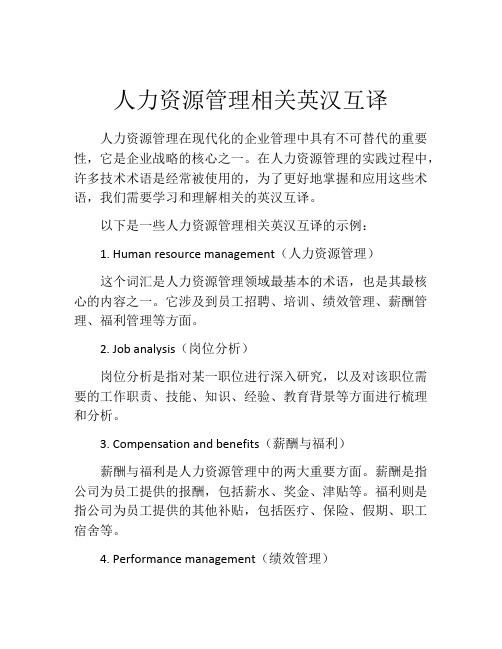
人力资源管理相关英汉互译人力资源管理在现代化的企业管理中具有不可替代的重要性,它是企业战略的核心之一。
在人力资源管理的实践过程中,许多技术术语是经常被使用的,为了更好地掌握和应用这些术语,我们需要学习和理解相关的英汉互译。
以下是一些人力资源管理相关英汉互译的示例:1. Human resource management(人力资源管理)这个词汇是人力资源管理领域最基本的术语,也是其最核心的内容之一。
它涉及到员工招聘、培训、绩效管理、薪酬管理、福利管理等方面。
2. Job analysis(岗位分析)岗位分析是指对某一职位进行深入研究,以及对该职位需要的工作职责、技能、知识、经验、教育背景等方面进行梳理和分析。
3. Compensation and benefits(薪酬与福利)薪酬与福利是人力资源管理中的两大重要方面。
薪酬是指公司为员工提供的报酬,包括薪水、奖金、津贴等。
福利则是指公司为员工提供的其他补贴,包括医疗、保险、假期、职工宿舍等。
4. Performance management(绩效管理)绩效管理是指对员工在工作中的表现进行评估和记录,帮助企业和员工掌握自己的工作效率和成长方向。
5. Organizational Development(组织发展)组织发展是指企业为了适应市场变化、实现战略目标等而采取的各种组织行为和管理手段,以提高组织的生产力和活力。
6. Recruitment and selection(招聘与选拔)招聘与选拔是指企业为了满足业务发展需要,从外部招聘和选拔适合岗位的人才,以填补新的或空缺职位。
7. Training and development(培训与发展)培训与发展是指为员工提供各种培训和发展机会,以帮助他们提高技能、知识和职业发展,提高整体组织绩效。
8. Employee motivation(员工激励)员工激励是指为了调动员工的工作积极性、提高工作热情和效率,采取的各种激励措施和管理手段。
人力资源英语作文
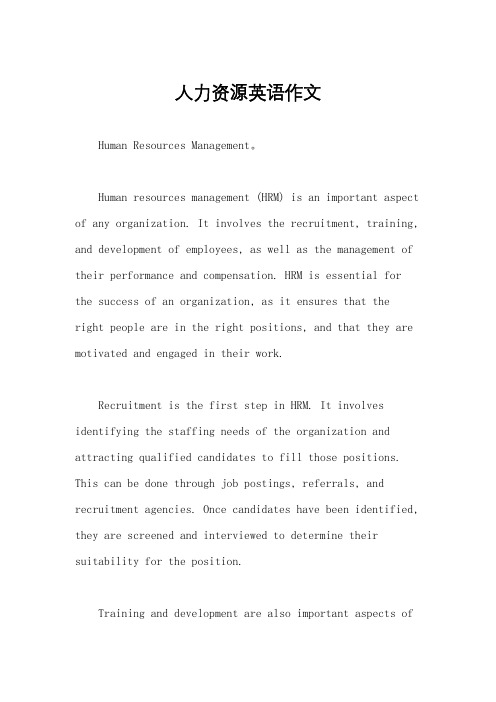
人力资源英语作文Human Resources Management。
Human resources management (HRM) is an important aspect of any organization. It involves the recruitment, training, and development of employees, as well as the management of their performance and compensation. HRM is essential for the success of an organization, as it ensures that theright people are in the right positions, and that they are motivated and engaged in their work.Recruitment is the first step in HRM. It involves identifying the staffing needs of the organization and attracting qualified candidates to fill those positions. This can be done through job postings, referrals, and recruitment agencies. Once candidates have been identified, they are screened and interviewed to determine their suitability for the position.Training and development are also important aspects ofHRM. Employees need to be trained to perform their jobs effectively, and to develop new skills and knowledge as the organization evolves. This can be done through on-the-job training, workshops, and seminars. In addition, employees may be offered opportunities for career development, such as promotions or job rotations.Performance management is another key aspect of HRM. It involves setting performance goals for employees and providing them with feedback on their progress. This helps to ensure that employees are meeting the expectations of the organization, and that their performance is aligned with the goals of the organization.Compensation is also an important aspect of HRM. Employees need to be compensated fairly for their work, and to be motivated to perform at their best. This can be done through a variety of compensation strategies, such as salary, bonuses, and benefits.In conclusion, human resources management is an essential aspect of any organization. It involves therecruitment, training, and development of employees, as well as the management of their performance and compensation. Effective HRM ensures that the right people are in the right positions, and that they are motivated and engaged in their work.。
人力资源管理英语词汇
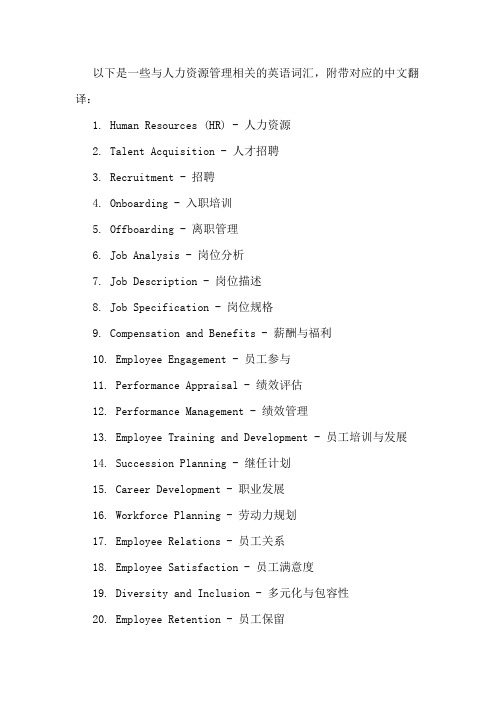
以下是一些与人力资源管理相关的英语词汇,附带对应的中文翻译:1. Human Resources (HR) - 人力资源2. Talent Acquisition - 人才招聘3. Recruitment - 招聘4. Onboarding - 入职培训5. Offboarding - 离职管理6. Job Analysis - 岗位分析7. Job Description - 岗位描述8. Job Specification - 岗位规格9. Compensation and Benefits - 薪酬与福利10. Employee Engagement - 员工参与11. Performance Appraisal - 绩效评估12. Performance Management - 绩效管理13. Employee Training and Development - 员工培训与发展14. Succession Planning - 继任计划15. Career Development - 职业发展16. Workforce Planning - 劳动力规划17. Employee Relations - 员工关系18. Employee Satisfaction - 员工满意度19. Diversity and Inclusion - 多元化与包容性20. Employee Retention - 员工保留21. HR Policies - 人力资源政策22. Labor Law - 劳动法23. Equal Employment Opportunity (EEO) - 平等就业机会24. Workplace Safety - 工作场所安全25. Employee Handbook - 员工手册26. Staffing - 人员配置27. Job Evaluation - 岗位评估28. Work-life Balance - 工作与生活平衡29. Flexible Work Arrangements - 弹性工作安排30. Employee Recognition - 员工认可31. Grievance Handling - 申诉处理32. HR Metrics - 人力资源指标33. HRIS (Human Resources Information System) - 人力资源信息系统34. Wellness Programs - 健康管理项目35. Employee Benefits Package - 员工福利计划36. Employee Assistance Program (EAP) - 员工援助计划37. Conflict Resolution - 冲突解决38. HR Compliance - 人力资源合规39. Job Rotation - 岗位轮换40. Organizational Culture - 组织文化41. HR Audit - 人力资源审计42. Employer Branding - 雇主品牌塑造43. HR Strategy - 人力资源战略44. Collective Bargaining - 集体谈判45. Inclusive Hiring - 包容性招聘46. Recruitment Metrics - 招聘指标47. HR Analytics - 人力资源分析48. Remote Work Policies - 远程工作政策49. Diversity Training - 多元化培训50. Exit Interviews - 离职面谈51. Workforce Diversity - 劳动力多样性52. Flexible Spending Account (FSA) - 弹性支出账户53. Health Savings Account (HSA) - 健康储蓄账户54. COBRA (Consolidated Omnibus Budget Reconciliation Act) - 库布里克法案(美国医疗保险法)55. Furlough - 临时休假56. Talent Management - 人才管理57. Labor Relations - 劳资关系58. Absence Management - 缺勤管理59. Employee Benefits Specialist - 员工福利专员60. HR Consulting - 人力资源咨询61. HR Specialist - 人力资源专员62. HR Generalist - 人力资源综合专员63. HR Manager - 人力资源经理64. HR Director - 人力资源总监65. HR Coordinator - 人力资源协调员66. Recruiter - 招聘专员67. Headhunter - 猎头68. Compensation Analyst - 薪酬分析师69. Workplace Harassment Training - 工作场所骚扰培训70. Employee Privacy Policy - 员工隐私政策71. HR Outsourcing - 人力资源外包72. HR Technology - 人力资源科技73. HR Software - 人力资源软件74. HR Best Practices - 人力资源最佳实践这些词汇涵盖了人力资源管理领域的关键概念,有助于理解和应用相关术语。
人力资源与企业的连接英文
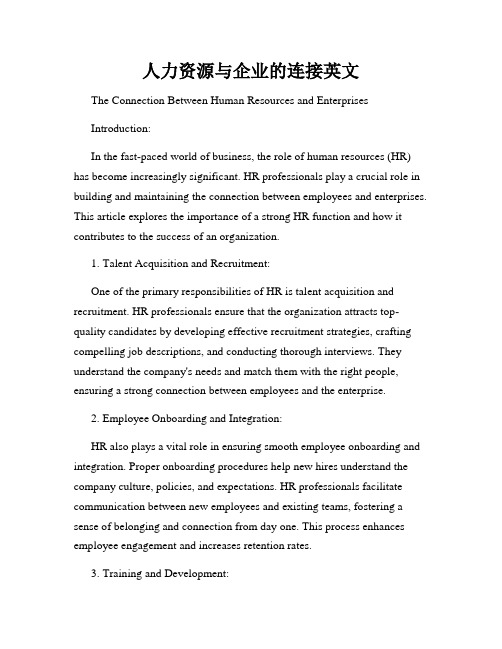
人力资源与企业的连接英文The Connection Between Human Resources and EnterprisesIntroduction:In the fast-paced world of business, the role of human resources (HR) has become increasingly significant. HR professionals play a crucial role in building and maintaining the connection between employees and enterprises. This article explores the importance of a strong HR function and how it contributes to the success of an organization.1. Talent Acquisition and Recruitment:One of the primary responsibilities of HR is talent acquisition and recruitment. HR professionals ensure that the organization attracts top-quality candidates by developing effective recruitment strategies, crafting compelling job descriptions, and conducting thorough interviews. They understand the company's needs and match them with the right people, ensuring a strong connection between employees and the enterprise.2. Employee Onboarding and Integration:HR also plays a vital role in ensuring smooth employee onboarding and integration. Proper onboarding procedures help new hires understand the company culture, policies, and expectations. HR professionals facilitate communication between new employees and existing teams, fostering a sense of belonging and connection from day one. This process enhances employee engagement and increases retention rates.3. Training and Development:Human resources professionals are responsible for designing and implementing training and development programs. By investing in employees' skills and knowledge, HR professionals ensure that the workforce remains competitive in a rapidly evolving business environment. These programs foster employee growth and enhance their connection to the organization, leading to higher job satisfaction and improved performance.4. Performance Management:HR plays a crucial role in managing and evaluating employee performance. They establish performance metrics, conduct performance appraisals, and provide feedback. By facilitating regular communication between managers and employees, HR ensures that goals are aligned, expectations are clarified, and performance issues are addressed. This process strengthens the connection between employees' efforts and the organization's overall objectives.5. Employee Engagement and Well-being:HR professionals are responsible for creating a positive work environment that promotes employee engagement and well-being. They develop employee wellness programs, organize team-building activities, and establish communication channels for employees to express their concerns. Such initiatives foster a sense of belonging and a strong connection between employees and the enterprise.6. Conflict Resolution and Employee Relations:In any organization, conflicts among employees may arise. HR professionals act as mediators, resolving conflicts and maintaining healthyemployee relations. By effectively addressing grievances, HR minimizes disruption and helps to strengthen the connection between individuals within the organization.7. Compliance and Legal Matters:HR professionals ensure that the organization complies with labor laws and regulations. They stay updated with changes in legislation to avoid legal issues and maintain ethical practices. Handling compliance matters not only protects the enterprise but also builds trust and credibility among employees, strengthening their connection to the organization.Conclusion:The connection between human resources and enterprises is crucial for sustainable success. HR professionals play a vital role in attracting and retaining talent, integrating employees into the organization, developing their skills, managing performance, and resolving conflicts. Their efforts create an environment where employees feel valued, connected, and motivated to contribute to the overall goals of the organization. Therefore, it is imperative for organizations to recognize the importance of a strong HR function and invest in its development. By nurturing this connection, enterprises can thrive in a competitive business landscape.。
人力资源英文(单词解释)
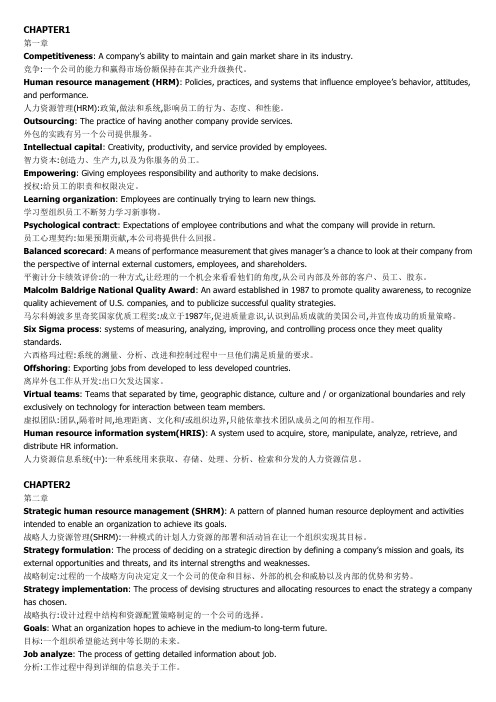
CHAPTER1第一章Competitiveness: A company’s ability to maintain and gain market share in its industry.竞争:一个公司的能力和赢得市场份额保持在其产业升级换代。
Human resource management (HRM): Policies, practices, and systems that influence employee’s behavior, attitudes, and performance.人力资源管理(HRM):政策,做法和系统,影响员工的行为、态度、和性能。
Outsourcing: The practice of having another company provide services.外包的实践有另一个公司提供服务。
Intellectual capital: Creativity, productivity, and service provided by employees.智力资本:创造力、生产力,以及为你服务的员工。
Empowering: Giving employees responsibility and authority to make decisions.授权:给员工的职责和权限决定。
Learning organization: Employees are continually trying to learn new things.学习型组织员工不断努力学习新事物。
Psychological contract: Expectations of employee contributions and what the company will provide in return.员工心理契约:如果预期贡献,本公司将提供什么回报。
Balanced scorecard: A means of performance measurement that gives manager’s a chance to look at their company from the perspective of internal external customers, employees, and shareholders.平衡计分卡绩效评价:的一种方式,让经理的一个机会来看看他们的角度,从公司内部及外部的客户、员工、股东。
人力资源专业词汇汇总 (中英文)超全 整理 的很辛苦的
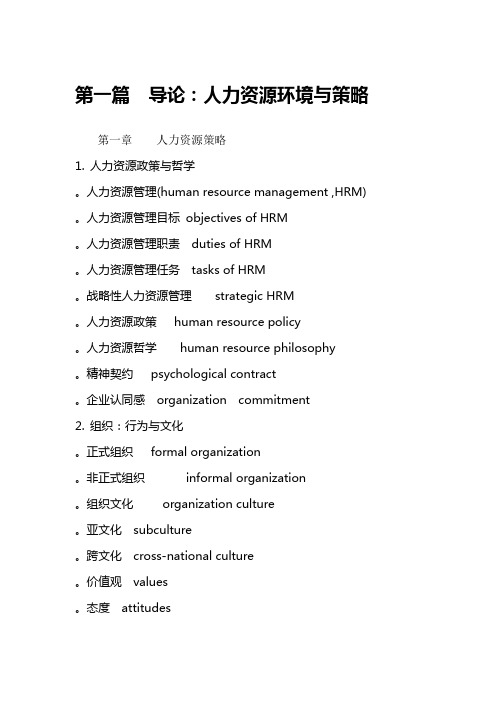
第一篇导论:人力资源环境与策略第一章人力资源策略1.人力资源政策与哲学。
人力资源管理(human resource management ,HRM) 。
人力资源管理目标objectives of HRM。
人力资源管理职责duties of HRM。
人力资源管理任务tasks of HRM。
战略性人力资源管理strategic HRM。
人力资源政策human resource policy。
人力资源哲学human resource philosophy。
精神契约psychological contract。
企业认同感organization commitment2.组织:行为与文化。
正式组织formal organization。
非正式组织informal organization。
组织文化organization culture。
亚文化subculture。
跨文化cross-national culture。
价值观values。
态度attitudes。
角色行为role behavior。
个人主义—集体主义individualism-collectivism。
不确定性规避uncertainty avoidance。
权力距离power distance。
直线和职能职权line and staff authority3.激励与组织绩效。
激励motivation。
需要层次理论hierarchy of needs theory。
X理论与Y理论theory X & theory Y。
组织体系Ⅰ与组织体系Ⅳsystem Ⅰ& system Ⅳ。
激励-保健理论motivation-hygiene theory。
ERG理论ERG theory。
麦克莱兰德需要理mc-clelland’s theory of needs。
期望理论expectency theory。
公平理论equity theory。
人力资源管理相关英汉互译

人力资源管理相关英汉互译The second critical tent pole of leadership is the personal capability the leader possesses. These personal capabilities are not skills that would typically be described as leadership skills, yet our research proves they must be in place for any individual to be perceived as a strong leader. Here are some of these individual capabilities:⏹Technical knowledge. The best leaders have at least a working knowledge of thetechnological side of the business.⏹Product knowledge. Great leaders need a thorough understanding of what theorganization produces and why it is superior to competitive products.⏹Problem analysis and problem-solving skills. These skills include the ability to defineproblems, analyze them, and come up with solid recommendations for resolving complex issues.⏹Professional skills. Excellent leaders must be able to write intelligently and concisely,make compelling presentations, organize their work efficiently, monitor progress, and work without close supervision.⏹Innovation. This refers to a leader's ability to have a fresh outlook in approaching aproblem, to shake loose from old methods, and see new possibilities.⏹Initiative. The best leaders see if something is falling between the cracks andimmediately step in to make certain it is handled.⏹Effective use of information technology. Great leaders set an example in theconsistent use of e-mail, powerful software applications, and any technology that escalates performance.Career experts, Gene Dalton and Paul Thompson, explain that the most successful leaders progress through a series of four career stages, which cannot be skipped. Stage one is the time when individuals must prove they can learn the business and develop a solid foundation of technical expertise. In stage two, individuals continue to build technical skills and become independent contributors. By stage three, they become wentors-developing the careers and expertise of others. In stage four, they become organizational visionaries—leading the organization in new directions.Too often, leaders reach a position they've been seeking and start to coast—believing the learning phase of their career is over. They assume that there is a time for learning and a time for execution, and they are done learning. The best leaders never quit learning.Here are some techniques to maximize your personal capability:Understand the technology: Employees can see through attempts to cover up your lack of knowledge. Get up to speed by asking questions. Be willing to admit what you don't know.Perfect professional Skills: Managers can't manage unless they can communicate.Try new things: Great managers innovate and take initiative. They think outside the box and don't hesitate to experiment."Leadership cannot be delegated to others."—John H. Zenger and Joseph FolkmanFocus on resultsLeadership is ultimately about producing results. This is the third leadership tent pole. Leaders can have talent and character, but unless they produce sustained, impressive results for their organization, they simply are not good leaders.One study of 1000 managers showed that the best managers translate ideas into action. They push to take the next step forward by bringing energy, enthusiasm, and urgency to their role. They continually look for ways to improve. These leaders are in the driver's seat, with a foot on the accelerator—pressed to the floorboard most of the time.How do leaders focus on results? Extraordinary leaders do the following:⏹Establish stretch goals for their people.⏹Take personal responsibility for the outcomes of the group.⏹Provide ongoing feedback and coaching to their people.⏹Set lofty targets for the group to achieve.⏹Personally sponsor an initiative or action.⏹Initiate new programs, projects, processes, client relationships, or technology.⏹Focus on organization goals and ensure that they are translated into actions by theirdepartment.⏹Operate with speed and intensity; accelerate the pace of the group.⏹Champion the cause of the customer.⏹Balance long-term and short-term objectives.The best leaders get things accomplished, even under duress. They choose the right goals and follow through.These are some ways to bring about results:Know What the organization expects: Ask, "What does the organization expect from my department?" "From me personally?" The answers can be quite eye-opening.Stay fOCUSed On long-ternr results: We've all seen executives who can make earnings soar—temporarily. Extraordinary leaders resist the urge to sacrifice long-term for short-term results. They keep the welfare of the organization ahead of their own personal agendas.Take action: Extraordinary leaders wake up in the morning with a plan and put it into effect. They don't always wait for permission before moving ahead. Instead, they simply try new things."Leaders who aren't getting results aren't truly leading."—David Ulrich, Jack Zenger, and Norm SmallwoodCultivate interpersonal skillsThe fourth essential tent pole of leadership is interpersonal skills. Along with the central tent pole representing character, it probably holds the most canvas. This leadership skill has become more important over time, especially since the demise of the "command and control" styles of leadership. Of all the competencies, interpersonal skills seem to make the most difference in whether leaders are considered extraordinary.To develop strong interpersonal skills, leaders must do the following:Communicate powerfully and prolifically. Extraordinary leaders don't hoard new insights. They tell people! These leaders give their work group a sense of direction and purpose. They help people understand how their work contributes to the goals of the organization. They err on the side of telling people too much.Inspire others to high performance. Great leaders energize people to go the extra mile. They set stretch goals that motivate people to accomplish more than they think is possible.Build trust. Superstar leaders act so that others trust them. They balance their concern for productivity and results with sensitivity to employees' needs and problems. When conflicts arise, they deal with employees' feelings as well as the technical aspects of the issue. They stay approachable.Develop others. The most remarkable leaders support others' growth by giving honest and constructive feedback, balancing correc tive with positive evaluations. They stay tuned to what is happening in employees' careers. They let others grow, even if it means letting them leave the department.Collaborate and develop strong teams. Excellent leaders know not to insulate themselves from other team members and departments. They keep in touch, so that cooperative urges beat out competitive urges. They cultivatetheir team members'ability to work with diverse people.Some key points for mastering people skills include:Involve Others in communication: One of the best ways to communicate is to get others to communicate! Interestingly, the worst communicators focus solely on getting their message across. The best communicators check people's reactions and get their ideas.Train everyone to be a leader: These days, leadership often gets passed around in a group. The person with the loftiest title and supposed power is no longer the one with all the answers. Believe that others are capable of great accomplishments and then watch them follow through.TO develop Others, develop yourself: The best leaders create space for their employees to move up from below by raising their own performance. Their efforts not only set the example, but also blaze a clear path for others to follow."If we treat people as they are, wemake them worse, but if we treat themas they ought to be, we help thembecome what they are capable ofbecoming."—Johann Wolfgang von GoetheLead organizational changeThe ability to lead organizational change is the fifth tent pole of extraordinary leadership. The best leaders inspire people to rally around a change, while poor leaders have to push, cajole, or even threaten employees to accept change. A turbulent business environment puts leaders to the test: excellent leaders can turn a significant change into a pleasant journey, while poorly led change might be better described as a "trip through hell." With most organizations today in a constant state of change—from dramatic growth to downsizing and restructuring—leaders must be able to skillfully shepherd organizations in new strategic directions.We're not talking about slight tactical shifts in current management processes or procedures. Caretaker managers can keep things going on a steady path. But if the organization is to rise to a significantly higher level of performance, extraordinary leaders must be able to sense the direction of the market and alter the fundamental business model. They must be able to envision and create a new organization culture.How do extraordinary leaders approach this task? The challenge in accomplishing change is not only to provide strong direction, but also to get people involved in making the change work. The most effective leaders are able to strike a balance between directing change and involving others.Leaders with strong directing tendencies are often prepared with well-organized plans that they communicate clearly. They maintain control, but sometimes end up with employees feeling that changes are being done to them but not with them. The end result is that employees resist change and start to distrust management.On the other hand, leaders who favor involving others in change sometimes fail to provide enough direction, leaving employees confused about their roles and what they need to do to keep the change moving forward. Sometimes leaders who tend toward involving others are simply unwilling to take risks or make tough decisions.Our research shows clearly that both sets of behaviors are necessary for a leader tomanage change effectively. Leaders need to help their people understand the specific details of the change and also help them feel involved so they will feel committed to the change.Leading organizational change requires that you:Create the Overarching Vision:Using your knowledge of the external environment, determine which trends to pursue and which to ignore. Stay involved in critical decisions. Use your influence to shape their outcome.Translate the vision into specific objectives: In order to make the strategic vision happen, break it down to the level of specific tasks and expectations for individual workers. It is up to you to determine how resources will be allocated. You must establish the norms that will shape the culture.Balance the need for direction with the need to involve others: Build support for your vision by getting people on board."Some people grin and bear it. Others smile and change it."—Unknown领导者需要个人能力领导能力中第二根重要的支杆是领导者所拥有的个人能力。
人力资源英语英汉对照

最基础的人力资源术语,大家一起来学习人力资源管理:(Human Resource Management ,HRM)人力资源经理:( human resource manager)高级管理人员:(executive)职业:(profession)道德标准:(ethics)操作工:(operative employees)专家:(specialist)人力资源认证协会:(the Human Resource Certification Institute,HRCI)外部环境:(external environment)内部环境:(internal environment)政策:(policy)企业文化:(corporate culture)目标:(mission)股东:(shareholders)非正式组织:(informal organization)跨国公司:(multinational corporation,MNC)管理多样性:(managing diversity)工作:(job)职位:(posting)工作分析:(job analysis)工作说明:(job description)工作规范:(job specification)工作分析计划表:(job analysis schedule,JAS)职位分析问卷调查法:(Management Position Description Questionnaire,MPDQ)行政秘书:(executive secretary)地区服务经理助理:(assistant district service manager)人力资源计划:(Human Resource Planning,HRP)战略规划:(strategic planning)长期趋势:(long term trend)要求预测:(requirement forecast)供给预测:(availability forecast)管理人力储备:(management inventory)裁减:(downsizing)人力资源信息系统:(Human Resource Information System,HRIS)招聘:(recruitment)员工申请表:(employee requisition)招聘方法:(recruitment methods)内部提升:(Promotion From Within ,PFW)工作公告:(job posting)广告:(advertising)职业介绍所:(employment agency)特殊事件:(special events)实习:(internship)选择:(selection)选择率:(selection rate)简历:(resume)标准化:(standardization)有效性:(validity)客观性:(objectivity)规范:(norm)录用分数线:(cutoff score)准确度:(aiming)业务知识测试:(job knowledge tests)求职面试:(employment interview)非结构化面试:(unstructured interview)结构化面试:(structured interview)小组面试:(group interview)职业兴趣测试:(vocational interest tests)会议型面试:(board interview)组织变化与人力资源开发人力资源开发:(Human Resource Development,HRD) 培训:(training)开发:(development)定位:(orientation)训练:(coaching)辅导:(mentoring)经营管理策略:(business games)案例研究:(case study)会议方法:(conference method)角色扮演:(role playing)工作轮换:(job rotating)在职培训:(on-the-job training ,OJT)媒介:(media)企业文化与组织发展企业文化:(corporate culture)组织发展:(organization development,OD)调查反馈:(survey feedback)质量圈:(quality circles)目标管理:(management by objective,MBO)全面质量管理:(Total Quality Management,TQM)团队建设:(team building)职业计划与发展职业:(career)职业计划:(career planning)职业道路:(career path)职业发展:(career development)自我评价:(self-assessment)职业动机:(career anchors)绩效评价绩效评价:(Performance Appraisal,PA)小组评价:(group appraisal)业绩评定表:(rating scales method)关键事件法:(critical incident method)排列法:(ranking method)平行比较法:(paired comparison)硬性分布法:(forced distribution method)晕圈错误:(halo error)宽松:(leniency)严格:(strictness)360°反馈:(360-degree feedback)叙述法:(essay method)集中趋势:(central tendency)报酬与福利报酬:(compensation)直接经济报酬:(direct financial compensation)间接经济报酬:(indirect financial compensation)非经济报酬:(no financial compensation)公平:(equity)外部公平:(external equity)内部公平:(internal equity)员工公平:(employee equity)小组公平:(team equity)工资水平领先者:(pay leaders)现行工资率:(going rate)工资水平居后者:(pay followers)劳动力市场:(labor market)工作评价:(job evaluation)排列法:(ranking method)分类法:(classification method)因素比较法:(factor comparison method)评分法:(point method)海氏指示图表个人能力分析法:(Hay Guide Chart-profile Method) 工作定价:(job pricing)工资等级:(pay grade)工资曲线:(wage curve)工资幅度:(pay range)12. 福利和其它报酬问题福利(间接经济补偿)员工股权计划:(employee stock ownership plan,ESOP)值班津贴:(shift differential)奖金:(incentive compensation)利润分享(分红制):(profit sharing)安全与健康的工作环境安全:(safety)健康:(health)频率:(frequency rate)紧张:(stress)角色冲突:(role conflict)催眠法:(hypnosis)酗酒:(alcoholism)员工和劳动关系工会:(union)地方工会:(local union)行业工会:(craft union)产业工会:(industrial union)全国工会:(national union)谈判组:(bargaining union)劳资谈判:(collective bargaining)仲裁:(arbitration)罢工:(strike)内部员工关系:(internal employee relations) 纪律:(discipline)纪律处分:(disciplinary action)申诉:(grievance)降职:(demotion)调动:(transfer)晋升:(promotion)目标mission/ objective集体目标group objective内部环境internal environment外部环境external environment计划planning组织organizing人事staffing领导leading控制controlling步骤process原理principle方法technique经理manager总经理general manager行政人员administrator主管人员supervisor企业enterprise商业business产业industry公司company效果effectiveness效率efficiency企业家entrepreneur权利power职权authority职责responsibility科学管理scientific management现代经营管理modern operational management行为科学behavior science生产率productivity激励motivate动机motive法律law法规regulation经济体系economic system管理职能managerial function产品product服务service利润profit满意satisfaction归属affiliation尊敬esteem自我实现self-actualization人力投入human input盈余surplus收入income成本cost资本货物capital goods机器machinery设备equipment建筑building存货inventory经验法the empirical approach人际行为法the interpersonal behavior approach集体行为法the group behavior approach协作社会系统法the cooperative social systems approach 社会技术系统法the social-technical systems approach 决策理论法the decision theory approach数学法the mathematical approach系统法the systems approach随机制宜法the contingency approach管理任务法the managerial roles approach 经营法the operational approach人际关系human relation心理学psychology态度attitude压力pressure冲突conflict招聘recruit鉴定appraisal选拔select培训train报酬compensation授权delegation of authority协调coordinate业绩performance考绩制度merit system表现behavior下级subordinate偏差deviation检验记录inspection record误工记录record of labor-hours lost销售量sales volume产品质量quality of products先进技术advanced technology顾客服务customer service策略strategy结构structure领先性primacy普遍性pervasiveness忧虑fear忿恨resentment士气morale解雇layoff批发wholesale零售retail程序procedure规则rule规划program预算budget共同作用synergy大型联合企业conglomerate资源resource购买acquisition增长目标growth goal专利产品proprietary product竞争对手rival晋升promotion管理决策managerial decision商业道德business ethics有竞争力的价格competitive price 供货商supplier小贩vendor利益冲突conflict of interests派生政策derivative policy开支帐户expense account批准程序approval procedure病假sick leave休假vacation工时labor-hour机时machine-hour资本支出capital outlay现金流量cash flow工资率wage rate税收率tax rate股息dividend现金状况cash position资金短缺capital shortage总预算overall budget资产负债表balance sheet可行性feasibility投入原则the commitment principle 投资回报return on investment生产能力capacity to produce实际工作者practitioner最终结果end result业绩performance个人利益personal interest福利welfare市场占有率market share创新innovation生产率productivity利润率profitability社会责任public responsibility董事会board of director组织规模size of the organization组织文化organizational culture目标管理management by objectives 评价工具appraisal tool激励方法motivational techniques控制手段control device个人价值personal worth优势strength弱点weakness机会opportunity威胁threat个人责任personal responsibility顾问counselor定量目标quantitative objective定性目标qualitative objective可考核目标verifiable objective优先priority工资表payroll策略strategy政策policy灵活性discretion多种经营diversification评估assessment一致性consistency应变策略consistency strategy公共关系public relation价值value抱负aspiration偏见prejudice审查review批准approval主要决定major decision分公司总经理division general manager 资产组合距阵portfolio matrix明星star问号question mark现金牛cash cow赖狗dog采购procurement人口因素demographic factor地理因素geographic factor公司形象company image产品系列product line合资企业joint venture破产政策liquidation strategy紧缩政策retrenchment strategy战术tactics追随followership个性individuality性格personality安全safety自主权latitude悲观的pessimistic静止的static乐观的optimistic动态的dynamic灵活的flexible抵制resistance敌对antagonism折中eclectic激励motivation潜意识subconscious地位status情感affection欲望desire压力pressure满足satisfaction自我实现的需要needs for self-actualization 尊敬的需要esteem needs归属的需要affiliation needs安全的需要security needs生理的需要physiological needs维持maintenance保健hygiene激励因素motivator概率probability强化理论reinforcement theory反馈feedback奖金bonus股票期权stock option劳资纠纷labor dispute缺勤率absenteeism人员流动turnover奖励reward特许经营franchise热诚zeal信心confidence鼓舞inspire要素ingredient忠诚loyalty奉献devotion作风style品质trait适应性adaptability进取性aggressiveness热情enthusiasm毅力persistence人际交往能力interpersonal skills行政管理能力administrative ability智力intelligence专制式领导autocratic leader民主式领导democratic leader自由放任式领导free-rein leader管理方格图the managerial grid工作效率work efficiency服从obedience领导行为leader behavior支持型领导supportive leadership参与型领导participative leadership指导型领导instrumental leadership成就取向型领导achievement-oriented leadershipAction learning:行动学习Alternation ranking method:交替排序法Annual bonus:年终分红Application forms:工作申请表Appraisal interview:评价面试Aptitudes:资质Arbitration:仲裁Attendance incentive plan:参与式激励计划Authority:职权Behavior modeling:行为模拟Behaviorally anchored rating scale (bars):行为锚定等级评价法Benchmark job:基准职位Benefits:福利Bias:个人偏见Boycott:联合抵制Bumping/layoff procedures:工作替换/临时解雇程序Burnout:耗竭Candidate-order error:候选人次序错误Capital accumulation program:资本积累方案Career anchors:职业锚Career cycle:职业周期Career planning and development:职业规划与职业发展Case study method:案例研究方法Central tendency:居中趋势Citations:传讯Civil Rights Act:民权法Classes:类Classification (or grading) method:归类(或分级)法Collective bargaining:集体谈判Comparable worth:可比价值Compensable factor:报酬因素Computerized forecas:计算机化预测Content validity:内容效度Criterion validity:效标效度Critical incident method:关键事件法Davis-Bacon Act (DBA):戴维斯─佩根法案Day-to-day-collective bargaining:日常集体谈判Decline stage:下降阶段Deferred profit-sharing plan:延期利润分享计划Defined benefit:固定福利Defined contribution:固定缴款Department of Labor job analysis:劳工部工作分析法Discipline:纪律Dismissal:解雇;开除Downsizing:精简Early retirement window:提前退休窗口Economic strike:经济罢工Edgar Schein:艾德加.施恩Employee compensation:职员报酬Employee orientation:雇员上岗引导Employee Retirement Income Security Act (ERISA) :雇员退休收入保障法案Employee services benefits:雇员服务福利Employee stock ownership plan (ESOP):雇员持股计划Equal Pay Act:公平工资法Establishment stage:确立阶段Exit interviews:离职面谈Expectancy chart:期望图表Experimentation:实验Exploration stage:探索阶段Fact-finder:调查Fair day's work:公平日工作Fair Labor Standards Act:公平劳动标准法案Flexible benefits programs:弹性福利计划Flex place:弹性工作地点Flextime:弹性工作时间Forced distribution method:强制分布法Four-day workweek:每周4天工作制Frederick Taylor:弗雷德里克.泰罗Functional control:职能控制Functional job analysis:功能性工作分析法Gain sharing:收益分享General economic conditions:一般经济状况Golden offerings:高龄给付Good faith bargaining:真诚的谈判Grade description:等级说明书Grades:等级Graphic rating scale:图尺度评价法Grid training:方格训练Grievance:抱怨Grievance procedure:抱怨程序Group life insurance:团体人寿保险Group pension plan:团体退休金计划Growth stage:成长阶段Guarantee corporation:担保公司Guaranteed fair treatment:有保证的公平对待Guaranteed piecework plan:有保障的计件工资制Halo effect:晕轮效应Health maintenance organization (HMO) :健康维持组织Illegal bargaining:非法谈判项目Impasse:僵持Implied authority:隐含职权Incentive plan:激励计划Individual retirement account (IRA) :个人退休账户In-house development center:企业内部开发中心Insubordination:不服从Insurance benefits:保险福利Interviews:谈话;面谈Job analysis:工作分析Job description:工作描述Job evaluation:职位评价Job instruction training (JIT) :工作指导培训Job posting:工作公告Job rotation:工作轮换Job sharing:工作分组Job specifications:工作说明书John Holland:约翰.霍兰德Junior board:初级董事会Layoff:临时解雇Leader attach training:领导者匹配训练Lifetime employment without guarantees:无保证终身解雇Line manager:直线管理者Local market conditions:地方劳动力市场Lockout:闭厂Maintenance stage:维持阶段Management assessment center:管理评价中心Management by objectives (MBO):目标管理法Management game:管理竞赛Management grid:管理方格训练Management process:管理过程Mandatory bargaining:强制谈判项目Mediation:调解Merit pay:绩效工资Merit raise:绩效加薪Mid career crisis sub stage:中期职业危机阶段Nondirective interview:非定向面试Occupational market conditions:职业市场状况Occupational orientation:职业性向Occupational Safety and Health Act:职业安全与健康法案Occupational Safety and Health Administration (OSHA):职业安全与健康管理局Occupational skills:职业技能On-the-job training (OJT) :在职培训Open-door:敞开门户Opinion survey:意见调查Organization development(OD):组织发展Outplacement counseling:向外安置顾问Paired comparison method:配对比较法Panel interview:小组面试Participant diary/logs:现场工人日记/日志Pay grade:工资等级Pension benefits:退休金福利Pension plans:退休金计划People-first values:"以人为本"的价值观Performance analysis:工作绩效分析Performance Appraisal interview:工作绩效评价面谈Personnel (or human resource) management:人事(或人力资源)管理Personnel replacement charts:人事调配图Piecework:计件Plant Closing law:工厂关闭法Point method Policies:政策Position Analysis Questionnaire (PAQ) :职位分析问卷Position replacement cards:职位调配卡Pregnancy discrimination act:怀孕歧视法案Profit-sharing plan:利润分享计划Programmed learning:程序化教学Qualifications inventories:资格数据库Quality circle:质量圈Ranking method:排序法Rate ranges:工资率系列Ratio analysis:比率分析Reality shock:现实冲击Reliability:信度Retirement:退休Retirement benefits:退休福利Retirement counseling:退休前咨询Rings of defense:保护圈Role playing:角色扮演Salary surveys:薪资调查Savings plan:储蓄计划Scallion plan:斯坎伦计划Scatter plot:散点分析Scientific management:科学管理Self directed teams:自我指导工作小组Self-actualization:自我实现Sensitivity training:敏感性训练Serialized interview:系列化面试Severance pay:离职金Sick leave:病假Situational interview:情境面试Skip-level interview:越级谈话Social security:社会保障Speak up! :讲出来!Special awards:特殊奖励Special management development techniques:特殊的管理开发技术Stabilization sub stage:稳定阶段Staff (service) function:职能(服务)功能Standard hour plan:标准工时工资Stock option:股票期权Straight piecework:直接计件制Strategic plan:战略规划Stress interview:压力面试Strictness/leniency:偏紧/偏松Strikes:罢工Structured interview:结构化面试Succession planning:接班计划Supplement pay benefits:补充报酬福利Supplemental unemployment benefits:补充失业福利Survey feedback:调查反馈Sympathy strike:同情罢工System Ⅳ:组织体系ⅣSystem I:组织体系Task analysis:任务分析Team building:团队建设Team or group:班组Termination:解雇;终止Termination at will:随意终止Theory X:X理论Theory Y:Y理论Third-party involvement:第三方介入Training:培训Transactional analysis (TA) :人际关系心理分析Trend analysis:趋势分析Trial sub stage:尝试阶段Unclear performance standards:绩效评价标准不清Unemployment insurance:失业保险Unfair labor practice strike:不正当劳工活动罢工Unsafe acts:不安全行为Unsafe conditions:不安全环境V alidity:效度V alue-based hiring:以价值观为基础的雇佣Vroom-Yetton leadership trainman:维罗姆-耶顿领导能力训练V ariable compensation:可变报酬V estibule or simulated training:新雇员培训或模拟V esting:特别保护权V oluntary bargaining:自愿谈判项目V oluntary pay cut:自愿减少工资方案V oluntary time off:自愿减少时间Wage carve:工资曲线Work samples:工作样本Work sampling technique:工作样本技术Work sharing:临时性工作分担Worker involvement:雇员参与计划Worker's benefits:雇员福利Adaptability 适应性Aligning Performance for Success 协调工作以求成功业绩Applied Learning 应用的知识Building a Successful Team 建立成功团队Building Customer Loyalty 对客户忠诚Building Partnerships 建立合作关系Building Strategic Working Relationships 建立战略性工作关系Building Trust 建立互信关系Coaching 辅导Communication 沟通Continuous Learning 不断学习Contributing to Team Success 对团队成功的贡献Customer Focus 以客户为中心Decision Making 决策Delegating Responsibility 授权Developing Others 发展他人Drive for Results 注重实效Energy 精力充沛Facilitation Change 推动变革Follow-up 跟进Formal Presentation 专业演讲技巧Gaining Commitment 具有使命感Impact 影响力Information Monitoring 采集信息Initiating Action 主动采取行动Innovation 创新Job Fit 胜任工作Leading Through Mission and Values 在使命与价值的认同中的领导才能Managing Conflict 解决冲突Managing Work (Includes Time Management) 管理工作(时间管理)Meeting Leadership 会议组织能力Meeting Participation 分享Negotiation 谈判Planning and Organizing 编制计划与组织能力Quality Orientation 质量定位Risk Taking 勇于冒险Safety Awareness 安全意识Sales Ability / Persuasiveness 销售能力/说服能力Strategic Leadership / Decision Making 战略性领导/决策制定Stress Tolerance 压力忍受能力Technical / Professional Knowledge and Skills 技术专业知识和技能Tenacity 坚忍不拔Work Standards 操作规范Action learning:行动学习Alternation ranking method:交替排序法Annual bonus:年终分红Application forms:工作申请表Appraisal interview:评价面试Aptitudes:资质Arbitration:仲裁Attendance incentive plan:参与式激励计划Authority:职权Behavior modeling:行为模拟Behaviorally anchored rating scale (bars):行为锚定等级评价法Benchmark job:基准职位Benefits:福利Bias:个人偏见Boycott:联合抵制Bumping/layoff procedures:工作替换/临时解雇程序Burnout:耗竭Candidate-order error:候选人次序错误Capital accumulation program:资本积累方案Career anchors:职业锚Career cycle:职业周期Career planning and development:职业规划与职业发展Case study method:案例研究方法Central tendency:居中趋势Citations:传讯Civil Rights Act:民权法Classes:类Classification (or grading) method:归类(或分级)法集体谈判Comparable worth:可比价值Compensable factor:报酬因素Computerized forecast:计算机化预测Content validity:内容效度Criterion validity:效标效度Critical incident method:关键事件法Davis-Bacon Act (DBA):戴维斯―佩根法案Day-to-day-collective bargaining:日常集体谈判Decline stage:下降阶段Deferred profit-sharing plan:延期利润分享计划Defined benefit:固定福利Defined contribution:固定缴款Department of Labor job analysis:劳工部工作分析法Discipline:纪律Dismissal:解雇;开除Downsizing:精简Early retirement window:提前退休窗口Economic strike:经济罢工Edgar Schein:艾德加•施恩Employee compensation:职员报酬Employee orientation:雇员上岗引导Employee Retirement Income Security Act (ERISA) :雇员退休收入保障法案Employee services benefits:雇员服务福利Employee stock ownership plan (ESOP) :雇员持股计划Equal Pay Act:公平工资法Establishment stage:确立阶段Exit interviews:离职面谈Expectancy chart:期望图表Experimentation:实验Exploration stage:探索阶段Fact-finder:调查Fair day’s work:公平日工作Fair Labor Standards Act:公平劳动标准法案Flexible benefits programs:弹性福利计划Flex place:弹性工作地点Flextime:弹性工作时间Forced distribution method:强制分布法Four-day workweek:每周天工作制Frederick Taylor:弗雷德里克•泰罗Functional control:职能控制Functional job analysis:功能性工作分析法沟通Communication个人发展Personal Development电子学习e-Learning项目管理Project Management领导艺术Leadership团队建设Team Building管理Management商务管理类行政管理Administrative Support人力资源Human Resources商法Business Law行业Industry客户服务Customer Service知识管理Knowledge Management电子商务e-Business市场Marketing金融/财会Finance & Accounting企业运营Operations财务服务Financial Services销售Salesable 有才干的,能干的adaptable 适应性强的active 主动的,活跃的aggressive 有进取心的ambitious 有雄心壮志的amiable 和蔼可亲的amicable 友好的analytical 善于分析的apprehensive 有理解力的aspiring 有志气的,有抱负的audacious 大胆的,有冒险精神的capable 有能力的,有才能的careful 办理仔细的candid 正直的competent 能胜任的constructive 建设性的cooperative 有合作精神的creative 富创造力的dedicated 有奉献精神的dependable 可靠的diplomatic 老练的,有策略的disciplined 守纪律的dutiful 尽职的well--educated 受过良好教育的efficient 有效率的energetic 精力充沛的expressivity 善于表达faithful 守信的,忠诚的frank 直率的,真诚的generous 宽宏大量的genteel 有教养的gentle 有礼貌的humorous 有幽默impartial 公正的independent 有主见的industrious 勤奋的ingenious 有独创性的motivated 目的明确的intelligent 理解力强的learned 精通某门学问的logical 条理分明的methodical 有方法的modest 谦虚的objective 客观的precise 一丝不苟的punctual 严守时刻的realistic 实事求是的responsible 负责的sensible 明白事理的sporting 光明正大的steady 踏实的systematic 有系统的purposeful 意志坚强的sweet-tempered 性情温和的temperate 稳健的tireless 孜孜不倦的name 姓名in. 英寸pen name 笔名ft. 英尺alias 别名street 街Mr. 先生road 路Miss 小姐district 区Ms (小姐或太太)house number 门牌Mrs. 太太lane 胡同,巷age 年龄height 身高bloodtype 血型weight 体重address 地址born 生于permanent address 永久住址birthday 生日province 省birthdate 出生日期city 市birthplace 出生地点county 县home phone 住宅电话prefecture 专区office phone 办公电话autonomous region 自治区business phone 办公电话nationality 民族;国籍current address 目前住址citizenship 国籍date of birth 出生日期native place 籍贯postal code 邮政编码duel citizenship 双重国籍marital status 婚姻状况family status 家庭状况married 已婚single 未婚divorced 离异separated 分居number of children 子女人数health condition 健康状况health 健康状况excellent (身体)极佳short-sighted 近视far-sighted 远视ID card 身份证date of availability 可到职时间membership 会员、资格president 会长vice-president 副会长director 理事standing director 常务理事society 学会association 协会secretary-general 秘书长research society 研究会work experience 工作经历occupational history 工作经历professionalhistory 职业经历specific experience 具体经历responsibilities 职责second job 第二职业achievements 工作成就,业绩administer 管理assist 辅助adapted to 适应于accomplish 完成(任务等)appointed 被认命的adept in 善于analyze 分析authorized 委任的;核准的behave 表现break the record 打破纪录breakthrough 关键问题的解决control 控制conduct 经营,处理cost 成本;费用create 创造demonstrate 证明,示范decrease 减少design 设计develop 开发,发挥devise 设计,发明direct 指导double 加倍,翻一番earn 获得,赚取effect 效果,作用eliminate 消除enlarge 扩大enrich 使丰富exploit 开发(资源,产品)enliven 搞活establish 设立(公司等);使开业evaluation 估价,评价execute 实行,实施expedite 加快;促进generate 产生good at 擅长于guide 指导;操纵improve 改进,提高initiate 创始,开创innovate 改革,革新invest 投资integrate 使结合;使一体化justified 经证明的;合法化的launch 开办(新企业)maintain 保持;维修modernize 使现代化negotiate 谈判nominated 被提名;被认命的overcome 克服perfect 使完善;改善perform 执行,履行profit 利润be promoted to 被提升为be proposed as 被提名(推荐)为realize 实现(目标)获得(利润)reconstruct 重建recorded 记载的refine 精练,精制registered 已注册的regenerate 更新,使再生replace 接替,替换retrieve 挽回revenue 收益,收入scientific 科学的,系统的self-dependence 自力更生serve 服务,供职settle 解决(问题等)shorten 减低……效能simplify 简化,精简spread 传播,扩大standard 标准,规格supervises 监督,管理supply 供给,满足systematize 使系统化test 试验,检验well-trained 训练有素的valuable 有价值的target 目标,指标working model 劳动模范advanced worker 先进工作者education 学历educational history 学历educational background 教育程度curriculum 课程major 主修minor 副修educational highlights 课程重点部分curriculum included 课程包括specialized courses 专门课程courses taken 所学课程special training 特别训练social practice 社会实践part-time jobs 业余工作summer jobs 暑期工作vacation jobs 假期工作refresher course 进修课程extracurricularactivities 课外活动physical activities 体育活动recreational activities 娱乐活动academic activities 学术活动social activities 社会活动rewards 奖励scholarship 奖学金excellent League member 优秀团员excellent leader 优秀干部student council 学生会off-job training 脱产培训in-job training 在职培训educational system 学制cademic year 学年semester 学期(美)term 学期(英)supervisor 论文导师pass 及格fail 不及格marks 分数examination 考试degree 学位post doctorate 博士后doctor(Ph.D) 博士master 硕士bachelor 学士graduate student 研究生abroad student 留学生abroad student 留学生undergraduate 大学肆业生government-supportedstudent 公费生commoner 自费生extern 走读生intern 实习生prize fellow 奖学金生boarder 寄宿生graduate 毕业生guest student 旁听生(英)auditor 旁听生(美)day-student 走读生objective 目标position desired 希望职位job objective 工作目标employment objective 工作目标career objective 职业目标position sought 谋求职位position wanted 希望职位position appliedfor 申请职位for more specializedwork 为更专门的工作for prospectsof promotion 为晋升的前途for higher responsibility 为更高层次的工作责任for wider experience 为扩大工作经验due to close-downof company 由于公司倒闭due to expiryof employment 由于雇用期满sought a betterjob 找到了更好的工作to seek a betterjob 找一份更好的工作hobbies 业余爱好play the guitar 弹吉他reading 阅读play chess 下棋play 话剧long distance running 长跑play bridge 打桥牌collecting stamps 集邮play tennis 打网球jogging 慢跑sewing 缝纫travelling 旅游listening to symphony 听交响乐do some clay scultures 搞泥塑。
人力资源管理基础【外文翻译】
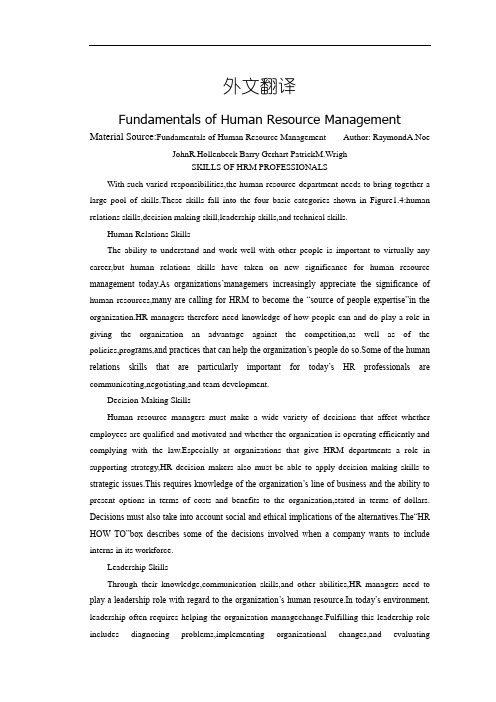
外文翻译Fundamentals of Human Resource Management Material Source:Fundamentals of Human Resource Management Author: RaymondA.Noe JohnR.Hollenbeck Barry Gerhart PatrickM.WrighSKILLS OF HRM PROFESSIONALSWith such varied responsibilities,the human resource department needs to bring together a large pool of skills.These skills fall into the four basic categories shown in Figure1.4:human relations skills,decision making skill,leadership skills,and technical skills.Human Relations SkillsThe ability to understand and work well with other people is important to virtually any career,but human relations skills have taken on new significance for human resource management today.As organizations’managemers increasingly appreciate the significance of human resources,many are calling for HRM to become the “source of people expertise”in the organization.HR managers therefore need knowledge of how people can and do play a role in giving the organization an advantage against the competition,as well as of the policies,prog rams,and practices that can help the organization’s people do so.Some of the human relations skills that are particularly important for today’s HR professionals are communicating,negotiating,and team development.Decision-Making SkillsHuman resource managers must make a wide variety of decisions that affect whether employees are qualified and motivated and whether the organization is operating efficiently and complying with the law.Especially at organizations that give HRM departments a role in supporting strategy,HR decision makers also must be able to apply decision making skills to strategic issues.This requires knowledge of the organization’s line of business and the ability to present options in terms of costs and benefits to the organization,stated in terms of dollars. Decisions must also take into account social and ethical implications of the alternatives.The“HR HOW TO”box describes some of the decisions involved when a company wants to include interns in its workforce.Leadership SkillsThrough their knowledge,communication skills,and other abilities,HR managers need to play a leadership role with regard to the organization’s human resource.In today’s environment, leadership often requires helping the organization managechange.Fulfilling this leadership role includes diagnosing problems,implementing organizational changes,and evaluatingresults,especially in terms of employees’ skills and attitudes.Changes typically produce conflict,resistance,and confusion among the people who must implement the new plans or programs.HR professionals must oversee the change in a way that ensure success.HRM provides tools for overcoming resistance to change, teaching employees to operate under new conditions,and even encouraging innovation. A survey of large corporations found that in 87 percent of the companies,organization development and change were managed by the HR department.Technical SkillsIn any field,including management,“technical skills”are the speccialized skills of that field.In humanresource management,professionals need knowledge of state of the art practices in such areas as staffing, development,rewards,organizational design,and communication.New selection techniques,performance appraisal methods,training programs,and incentive plans are constantly being developed.These developments often include the use of new software and computer systems.New laws are passed every year,and technical skills require knowledge of how to comply.Professionals must be able to evaluate the worth of the techniques that are available for carrying out HRM activities.Some of the new methods and tools will provide value to the organization,whereas others may be no more than the HRM equivalent of snake oil.HRM professionals must be able to critically evaluate new techniques in light of HRM principles and business value to determine which are beneficial.HUMAN RESOURCES AND COMPANY PERFORMANCEManagers and economists traditionally have seen human resource management as a necessary expense,rather than as a source of value to their organizations.Economic value is usually associated with capital-cash,equipment, technology,and facilities.However,.research has demonstrated that HRM practices can be valuable. Decisions such as whom to hire,what to pay,what training to offer,and how to evaluate employee performance directly affect employees’motivation and ability to provide goods and services that customers panies that attempt to increase their competitiveness by investing in new technology and promoting quality throughout the organization aslo invest in state of the art staffing,training,and compensation practices.The concept of “human resource management”implies that employees are resources of the employer.As a type of resource,human capital means the organization’s employees,d escribed in term of their training,experience,judgement,intelligence,relationships,and insight-the employee characteristics that can add economic value to the organization.In other words,whether it manufactures automobiles or forecasts the whether,for an organization to succeed at what itdoes,it needs employees with certain qualities,such as particular kinds of training and experience.This view means employees in today’s organizations are not interchangeable,easily replaced parts of a system but the source of the company’s success or failure.By influencing who works for the organization and how those people work,human resource management therefore contributes to such basic measures of an organization’s success as quality,profitability,and customer satisfaction..RESPONSIBILITIES OF HUMAN RESOURCE DEPARTMENTS In all but the smallest organizations,a human resource department is responsible for the functions of human resource management.On average,an organization has one HR staff person for every 100 employees served bu the department.Table1.1 details the responsibilities of human resource departments.SOURCE:Based on SHRM-BNA Survey No.66“Policy and Practice Forum:Human Resource Activities,Budgets,and Staffs,2000-2001,”Bulletin to management,Bureau of National Affairs Policy and Practice Series(Washington,DC:Bureau of National Affairs,June 28,2001) Although the human resource department has responsibility for these areas,many of the tasks may be performed by supervisors or others inside or outside the organization.No two human resource departments have precisely the same roles because of differences in organization sizes and characteristics of the workforce,the industry,and management’s values.In some companies,the HR department handles all the activities listed in Table1.1.In others,it mayshare the roles and duties with managers of other departments such as finance,operations, or information technology.In some companies,the HR department actively advises top management.In others,the department responds to top –level management decisions and implements staffing,training,and compensation activities in light of company strategy and polies.译文人力资源管理基础资料来源:人力资源管理基础作者:RaymondA.Noe著人力资源专业人员的技能由于人力资源部门承担着各式各样的职责,需要集中运用大量的技能。
人力资源常用词汇英汉对照
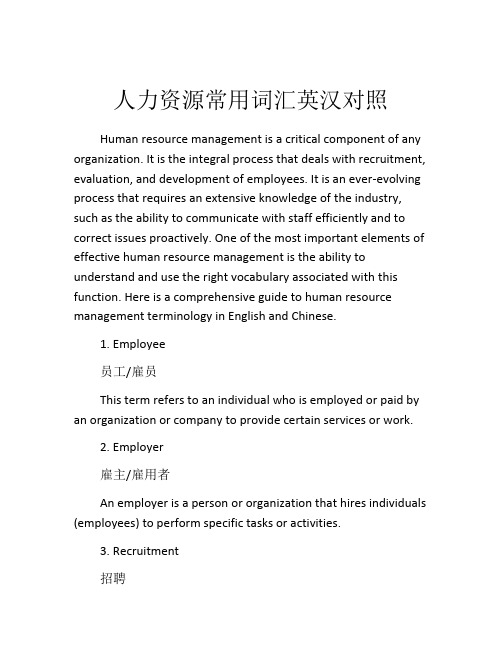
人力资源常用词汇英汉对照Human resource management is a critical component of any organization. It is the integral process that deals with recruitment, evaluation, and development of employees. It is an ever-evolving process that requires an extensive knowledge of the industry, such as the ability to communicate with staff efficiently and to correct issues proactively. One of the most important elements of effective human resource management is the ability to understand and use the right vocabulary associated with this function. Here is a comprehensive guide to human resource management terminology in English and Chinese.1. Employee员工/雇员This term refers to an individual who is employed or paid by an organization or company to provide certain services or work.2. Employer雇主/雇用者An employer is a person or organization that hires individuals (employees) to perform specific tasks or activities.3. Recruitment招聘Recruitment is the process of identifying and hiring the right person for a given position. It involves posting the job vacancy, shortlisting resumes, and conducting interviews.4. Job Description工作描述A job description is a detailed document that outlines the tasks, responsibilities, qualifications, and expectations of a particular job or position.5. Job Posting职位发布A job posting is an advertisement placed by an organization to attract candidates to apply for the job vacancy.6. Resume/CV简历A resume or curriculum vitae (CV) is a document that summarizes an individual's work experience, education, and skills used for job applications.7. Interview面试An interview is a formal meeting between an employer and a job applicant to assess the candidate's suitability for a specific job.8. Background Check背景调查/调查证明A background check is a process of verifying an individual's identity, education, criminal record, and work experience.9. Orientation入职培训/新员工介绍Orientation is an activity that aims to introduce new employees to the company's culture, policies, and procedures.10. Performance Management绩效管理Performance management is the process of establishing clear expectations and objectives for employees, monitoring their progress, and providing feedback to improve performance.11. Training and Development培训和发展Training and development is an ongoing process of educating employees to enhance their skills, knowledge, and abilities to perform their job effectively.12. Benefits福利Benefits are offerings provided by an organization to employees in addition to their regular salary. It can include paid time off, health insurance, retirement plans, etc.13. Compensation薪酬Compensation is the financial rewards and benefits that an employee receives in exchange for their work.14. Performance Appraisal绩效评估Performance appraisal is a formal process of assessing employee's job performance and providing feedback to improve future performance.15. Termination解雇Termination is the process of ending employment due to voluntary resignation or termination by the employer.In conclusion, the vocabulary of human resource management is essential for effective communication in this sector. Understanding the above terms in both English and Chinese is essential in the recruitment and management of employees to achieve desired business objectives.。
人力资源术语英汉对照
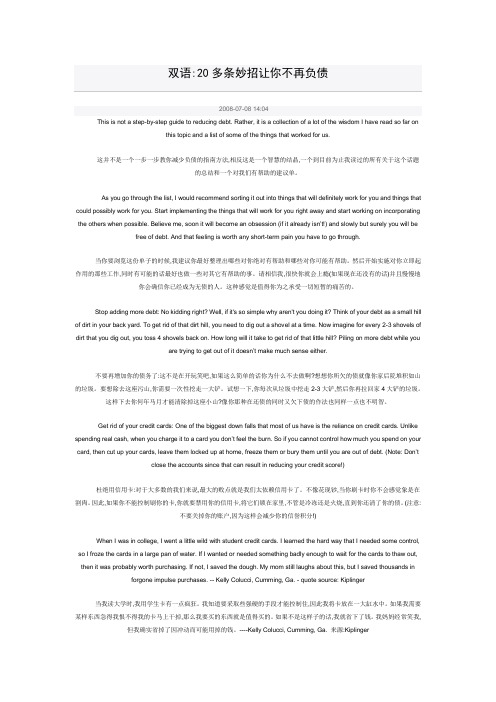
2008-07-08 14:04This is not a step-by-step guide to reducing debt. Rather, it is a collection of a lot of the wisdom I have read so far onthis topic and a list of some of the things that worked for us.这并不是一个一步一步教你减少负债的指南方法,相反这是一个智慧的结晶,一个到目前为止我读过的所有关于这个话题的总结和一个对我们有帮助的建议单。
As you go through the list, I would recommend sorting it out into things that will definitely work for you and things that could possibly work for you. Start implementing the things that will work for you right away and start working on incorporating the others when possible. Believe me, soon it will become an obsession (if it already isn’t!) and slowly but surely you will be free of debt. And that feeling is worth any short-term pain you have to go through.当你要浏览这份单子的时候,我建议你最好整理出哪些对你绝对有帮助和哪些对你可能有帮助。
然后开始实施对你立即起作用的那些工作,同时有可能的话最好也做一些对其它有帮助的事。
HR管理词汇英汉对照

人力资源管理词汇人力资源管理词汇Chinese<humanresources>English"以人为本"的价值观<humanresources>People-first value sX理论<humanresources>TheoryXY理论<humanresources>TheoryY艾德加?施恩<humanresources>EdgarSchein案例研究方法<humanresources>Casestudymethod罢工<humanresources>Strikes班组<humanresources>Teamorgroup保护圈<humanresources>Ringsofdefense保险福利<humanresources>Insurancebenefits报酬因素<humanresources>Compensablefactor抱怨<humanresources>Grievance抱怨程序<humanresources>Grievanceprocedure比率分析<humanresources>Ratioanalysis闭厂<humanresources>Lockout标准工时工资<humanresources>Standardhourplan病假<humanresources>Sickleave补充报酬福利<humanresources>Supplementpaybenefits补充失业福利<humanresources>Supplementalunemploymentbenefits 不安全环境<humanresources>Unsafeconditions不安全行为<humanresources>Unsafeacts不服从<humanresources>Insubordination不正当劳工活动罢工<humanresources>Unfairlaborpracticestrike参与式激励计划<humanresources>Attendanceincentiveplan尝试阶段<humanresources>Trialsubstage敞开门户<humanresources>Open-door成长阶段<humanresources>Growthstage程序化教学<humanresources>Programmedlearning初级董事会<humanresources>Juniorboard储蓄计划<humanresources>Savingsplan传讯<humanresources>Citations戴维斯―佩根法案<humanresources>Davis-BaconAct(DBA)担保公司<humanresources>Guaranteecorporation弹性福利计划<humanresources>Flexiblebenefitsprograms弹性工作地点<humanresources>Flexplace弹性工作时间<humanresources>Flextime等级<humanresources>Grades等级说明书<humanresources>Gradede script ion地方劳动力市场<humanresources>Localmarketconditions第三方介入<humanresources>Third-partyinvolvement调查<humanresources>Fact-finder调查反馈<humanresources>Surveyfeedback调解<humanresources>Mediation方格训练<humanresources>Gridtraining非定向面试<humanresources>Nondirectiveinterview非法谈判项目<humanresources>Illegalbargaining弗雷德里克?泰罗<humanresources>FrederickTaylor福利<humanresources>Benefits高龄给付<humanresources>Goldenofferings个人偏见<humanresources>Bias个人退休账户<humanresources>Individualretirementaccount(IRA) 工厂关闭法<humanresources>PlantClosinglaw工资等级<humanresources>Paygrade工资率系列<humanresources>Rateranges工资曲线<humanresources>Wagecarve工作分析<humanresources>Jobanalysis工作分组<humanresources>Jobsharing工作公告<humanresources>Jobposting工作绩效分析<humanresources>Performanceanalysis工作绩效评价面谈<humanresources>PerformanceAppraisalinterview工作轮换<humanresources>Jobrotation工作描述<humanresources>Jobde script ion工作申请表<humanresources>Applicationforms工作说明书<humanresources>Jobspecifications工作替换/临时解雇程序<humanresources>Bumping/layoffprocedures工作样本<humanresources>Worksamples工作样本技术<humanresources>Worksamplingtechnique工作指导培训<humanresources>Jobinstructiontraining(JIT)公平工资法<humanresources>EqualPayAct公平劳动标准法案<humanresources>FairLaborStandardsAct公平日工作<humanresources>Fairday'swork功能性工作分析法<humanresources>Functionaljobanalysis股票期权<humanresources>Stockoption固定福利<humanresources>Definedbenefit固定缴款<humanresources>Definedcontribution雇员参与计划<humanresources>Workerinvolvement雇员持股计划<humanresources>Employeestockownershipplan(ESOP)雇员服务福利<humanresources>Employeeservicesbenefits雇员福利<humanresources>Worker'sbenefits雇员上岗引导<humanresources>Employeeorientation雇员退休收入保障法案<humanresources>EmployeeRetirementIncomeSecurityAct(ERISA) 关键事件法<humanresources>Criticalincidentmethod管理方格训练<humanresources>Managementgrid管理过程<humanresources>Managementprocess管理竞赛<humanresources>Managementgame管理评价中心<humanresources>Managementassessmentcenter归类(或分级)法<humanresources>Classification(orgrading)method 耗竭<humanresources>Burnout候选人次序错误<humanresources>Candidate-ordererror怀孕歧视法案<humanresources>Pregnancydiscriminationact基准职位<humanresources>Benchmarkjob绩效工资<humanresources>Meritpay绩效加薪<humanresources>Meritraise绩效评价标准不清<humanresources>Unclearperformancestandards激励计划<humanresources>Incentiveplan集体谈判<humanresources>Collectivebargaining计件<humanresources>Piecework计算机化预测<humanresources>Computerizedforecast纪律<humanresources>Discipline健康维持组织<humanresources>Healthmaintenanceorganization(HMO) 僵持<humanresources>Impasse讲出来!<humanresources>Speakup!交替排序法<humanresources>Alternationrankingmethod角色扮演<humanresources>Roleplaying接班计划<humanresources>Successionplanning结构化面试<humanresources>Structuredinterview解雇;开除<humanresources>Dismissal解雇;终止<humanresources>Termination经济罢工<humanresources>Economicstrike精简<humanresources>Downsizing居中趋势<humanresources>Centraltendency科学管理<humanresources>Scientificmanagement可比价值<humanresources>Comparableworth可变报酬<humanresources>Variablecompensation劳工部工作分析法<humanresources>DepartmentofLaborjobanalysis类<humanresources>Classes离职金<humanresources>Severancepay离职面谈<humanresources>Exitinterviews利润分享计划<humanresources>Profit-sharingplan联合抵制<humanresources>Boycott临时解雇<humanresources>Layoff临时性工作分担<humanresources>Worksharing领导者匹配训练<humanresources>Leaderattachtraining每周4天工作制<humanresources>Four-dayworkweek民权法<humanresources>CivilRightsAct敏感性训练<humanresources>Sensitivitytraining目标管理法<humanresources>Managementbyobjectives(MBO)内容效度<humanresources>Contentvalidity年终分红<humanresources>Annualbonus排序法<humanresources>Rankingmethod培训<humanresources>Training配对比较法<humanresources>Pairedcomparisonmethod偏紧/偏松<humanresources>Strictness/leniency评价面试<humanresources>Appraisalinterview期望图表<humanresources>Expectancychart企业内部开发中心<humanresources>In-housedevelopmentcenter强制分布法<humanresources>Forceddistributionmethod强制谈判项目<humanresources>Mandatorybargaining情境面试<humanresources>Situationalinterview趋势分析<humanresources>Trendanalysis确立阶段<humanresources>Establishmentstage人际关系心理分析<humanresources>Transactionalanalysis(TA)人事(或人力资源)管理<humanresources>Personnel(orhumanresource)management人事调配图<humanresources>Personnelreplacementcharts任务分析<humanresources>Taskanalysis日常集体谈判<humanresources>Day-to-day-collectivebargaining散点分析<humanresources>Scatterplot社会保障<humanresources>Socialsecurity失业保险<humanresources>Unemploymentinsurance实验<humanresources>Experimentation收益分享<humanresources>Gainsharing斯坎伦计划<humanresources>Scallionplan随意终止<humanresources>Terminationatwill谈话;面谈<humanresources>Interviews探索阶段<humanresources>Explorationstage特别保护权<humanresources>Vesting特殊的管理开发技术<humanresources>Specialmanagementdevelopmenttechniques 特殊奖励<humanresources>Specialawards提前退休窗口<humanresources>Earlyretirementwindow同情罢工<humanresources>Sympathystrike图尺度评价法<humanresources>Graphicratingscale团队建设<humanresources>Teambuilding团体人寿保险<humanresources>Grouplifeinsurance团体退休金计划<humanresources>Grouppensionplan退休<humanresources>Retirement退休福利<humanresources>Retirementbenefits退休金福利<humanresources>Pensionbenefits退休金计划<humanresources>Pensionplans退休前咨询<humanresources>Retirementcounseling维持阶段<humanresources>Maintenancestage维罗姆-耶顿领导能力训练<humanresources>Vroom-Yettonleadershiptrainman稳定阶段<humanresources>Stabilizationsubstage无保证终身解雇<humanresources>Lifetimeemploymentwithoutguarantees 系列化面试<humanresources>Serializedinterview下降阶段<humanresources>Declinestage现场工人日记/日志<humanresources>Participantdiary/logs现实冲击<humanresources>Realityshock向外安置顾问<humanresources>Outplacementcounseling小组面试<humanresources>Panelinterview效标效度<humanresources>Criterionvalidity效度<humanresources>Validity新雇员培训或模拟<humanresources>Vestibuleorsimulatedtraining薪资调查<humanresources>Salarysurveys信度<humanresources>Reliability行动学习<humanresources>Actionlearning行为锚定等级评价法<humanresources>Behaviorallyanchoredratingscale(bars) 行为模拟<humanresources>Behaviormodeling压力面试<humanresources>Stressinterview延期利润分享计划<humanresources>Deferredprofit-sharingplan一般经济状况<humanresources>Generaleconomicconditions以价值观为基础的雇佣<humanresources>value-basedhiring意见调查<humanresources>Opinionsurvey隐含职权<humanresources>Impliedauthority有保障的计件工资制<humanresources>Guaranteedpieceworkplan有保证的公平对待<humanresources>Guaranteedfairtreatment约翰?霍兰德<humanresources>JohnHolland越级谈话<humanresources>Skip-levelinterview晕轮效应<humanresources>Haloeffect在职培训<humanresources>On-the-jobtraining(OJT)战略规划<humanresources>Strategicplan真诚的谈判<humanresources>Goodfaithbargaining政策<humanresources>Pointmethod/Policies直接计件制<humanresources>Straightpiecework直线管理者<humanresources>Linemanager职能(服务)功能<humanresources>Staff(service)function职能控制<humanresources>Functionalcontrol职权<humanresources>Authority职位调配卡<humanresources>Positionreplacementcards职位分析问卷<humanresources>PositionAnalysisQuestionnaire(PAQ)职位评价<humanresources>Jobevaluation职业安全与健康法案<humanresources>OccupationalSafetyandHealthAct职业安全与健康管理局<humanresources>OccupationalSafetyandHealthAdministration(OSHA) 职业规划与职业发展<humanresources>Careerplanninganddevelopment职业技能<humanresources>Occupationalskills职业锚<humanresources>Careeranchors职业市场状况<humanresources>Occupationalmarketconditions职业性向<humanresources>Occupationalorientation职业周期<humanresources>Careercycle职员报酬<humanresources>Employeecompensation质量圈<humanresources>Qualitycircle中期职业危机阶段<humanresources>Midcareercrisissubstage仲裁<humanresources>Arbitration资本积累方案<humanresources>Capitalaccumulationprogram资格数据库<humanresources>Qualificationsinventories资质<humanresources>Aptitudes自我实现<humanresources>Self-actualization自我指导工作小组<humanresources>Selfdirectedteams自愿减少工资方案<humanresources>Voluntarypaycut自愿减少时间<humanresources>Voluntarytimeoff自愿谈判项目<humanresources>Voluntarybargaining组织发展<humanresources>Organizationdevelopment(OD) 组织体系Ⅰ<humanresources>SystemI组织体系Ⅳ<humanresources>SystemⅣ。
HR管理词汇英汉对照
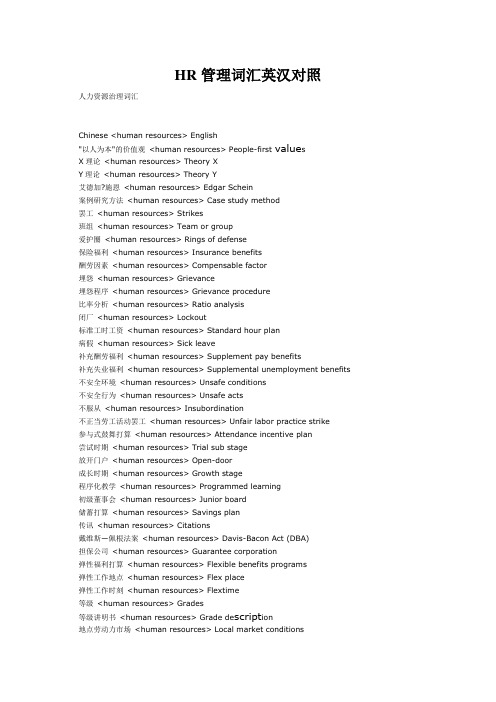
HR管理词汇英汉对照人力资源治理词汇Chinese <human resources> English"以人为本"的价值观<human resources> People-first value sX理论<human resources> Theory XY理论<human resources> Theory Y艾德加?施恩<human resources> Edgar Schein案例研究方法<human resources> Case study method罢工<human resources> Strikes班组<human resources> Team or group爱护圈<human resources> Rings of defense保险福利<human resources> Insurance benefits酬劳因素<human resources> Compensable factor埋怨<human resources> Grievance埋怨程序<human resources> Grievance procedure比率分析<human resources> Ratio analysis闭厂<human resources> Lockout标准工时工资<human resources> Standard hour plan病假<human resources> Sick leave补充酬劳福利<human resources> Supplement pay benefits补充失业福利<human resources> Supplemental unemployment benefits 不安全环境<human resources> Unsafe conditions不安全行为<human resources> Unsafe acts不服从<human resources> Insubordination不正当劳工活动罢工<human resources> Unfair labor practice strike参与式鼓舞打算<human resources> Attendance incentive plan尝试时期<human resources> Trial sub stage放开门户<human resources> Open-door成长时期<human resources> Growth stage程序化教学<human resources> Programmed learning初级董事会<human resources> Junior board储蓄打算<human resources> Savings plan传讯<human resources> Citations戴维斯―佩根法案<human resources> Davis-Bacon Act (DBA)担保公司<human resources> Guarantee corporation弹性福利打算<human resources> Flexible benefits programs弹性工作地点<human resources> Flex place弹性工作时刻<human resources> Flextime等级<human resources> Grades等级讲明书<human resources> Grade de script ion地点劳动力市场<human resources> Local market conditions第三方介入<human resources> Third-party involvement调查<human resources> Fact-finder调查反馈<human resources> Survey feedback调解<human resources> Mediation方格训练<human resources> Grid training非定向面试<human resources> Nondirective interview非法谈判项目<human resources> Illegal bargaining弗雷德里克?泰罗<human resources> Frederick Taylor福利<human resources> Benefits高龄给付<human resources> Golden offerings个人偏见<human resources> Bias个人退休账户<human resources> Individual retirement account (IRA)工厂关闭法<human resources> Plant Closing law工资等级<human resources> Pay grade工资率系列<human resources> Rate ranges工资曲线<human resources> Wage carve工作分析<human resources> Job analysis工作分组<human resources> Job sharing工作公告<human resources> Job posting工作绩效分析<human resources> Performance analysis工作绩效评判面谈<human resources> Performance Appraisal interview工作轮换<human resources> Job rotation工作描述<human resources> Job de script ion工作申请表<human resources> Application forms工作讲明书<human resources> Job specifications工作替换/临时解雇程序<human resources> Bumping/layoff procedures工作样本<human resources> Work samples工作样本技术<human resources> Work sampling technique工作指导培训<human resources> Job instruction training (JIT)公平工资法<human resources> Equal Pay Act公平劳动标准法案<human resources> Fair Labor Standards Act公平日工作<human resources> Fair day's work功能性工作分析法<human resources> Functional job analysis股票期权<human resources> Stock option固定福利<human resources> Defined benefit固定缴款<human resources> Defined contribution雇员参与打算<human resources> Worker involvement雇员持股打算<human resources> Employee stock ownership plan (ESOP)雇员服务福利<human resources> Employee services benefits雇员福利<human resources> Worker's benefits雇员上岗引导<human resources> Employee orientation雇员退休收入保证法案<human resources> Employee Retirement Income Security Act (ERISA)关键事件法<human resources> Critical incident method治理方格训练<human resources> Management grid治理过程<human resources> Management process治理竞赛<human resources> Management game治理评判中心<human resources> Management assessment center归类(或分级)法<human resources> Classification (or grading) method 耗竭<human resources> Burnout候选人次序错误<human resources> Candidate-order error怀孕鄙视法案<human resources> Pregnancy discrimination act基准职位<human resources> Benchmark job绩效工资<human resources> Merit pay绩效加薪<human resources> Merit raise绩效评判标准不清<human resources> Unclear performance standards鼓舞打算<human resources> Incentive plan集体谈判<human resources> Collective bargaining计件<human resources> Piecework运算机化推测<human resources> Computerized forecast纪律<human resources> Discipline健康坚持组织<human resources> Health maintenance organization (HMO) 僵持<human resources> Impasse讲出来!<human resources> Speak up!交替排序法<human resources> Alternation ranking method角色扮演<human resources> Role playing接班打算<human resources> Succession planning结构化面试<human resources> Structured interview解雇;开除<human resources> Dismissal解雇;终止<human resources> Termination经济罢工<human resources> Economic strike精简<human resources> Downsizing居中趋势<human resources> Central tendency科学治理<human resources> Scientific management可比价值<human resources> Comparable worth可变酬劳<human resources> Variable compensation劳工部工作分析法<human resources> Department of Labor job analysis类<human resources> Classes离职金<human resources> Severance pay离职面谈<human resources> Exit interviews利润分享打算<human resources> Profit-sharing plan联合抵制<human resources> Boycott临时解雇<human resources> Layoff临时性工作分担<human resources> Work sharing领导者匹配训练<human resources> Leader attach training每周4天工作制<human resources> Four-day workweek民权法<human resources> Civil Rights Act敏锐性训练<human resources> Sensitivity training目标治理法<human resources> Management by objectives (MBO)内容效度<human resources> Content validity年终分红<human resources> Annual bonus排序法<human resources> Ranking method培训<human resources> Training配对比较法<human resources> Paired comparison method偏紧/偏松<human resources> Strictness/leniency评判面试<human resources> Appraisal interview期望图表<human resources> Expectancy chart企业内部开发中心<human resources> In-house development center强制分布法<human resources> Forced distribution method强制谈判项目<human resources> Mandatory bargaining情境面试<human resources> Situational interview趋势分析<human resources> Trend analysis确立时期<human resources> Establishment stage人际关系心理分析<human resources> Transactional analysis (TA)人事(或人力资源)治理<human resources> Personnel (or human resource) management 人事调配图<human resources> Personnel replacement charts任务分析<human resources> Task analysis日常集体谈判<human resources> Day-to-day-collective bargaining散点分析<human resources> Scatter plot社会保证<human resources> Social security失业保险<human resources> Unemployment insurance实验<human resources> Experimentation收益分享<human resources> Gain sharing斯坎伦打算<human resources> Scallion plan随意终止<human resources> Termination at will谈话;面谈<human resources> Interviews探究时期<human resources> Exploration stage专门爱护权<human resources> Vesting专门的治理开发技术<human resources> Special management development techniques专门奖励<human resources> Special awards提早退休窗口<human resources> Early retirement window同情罢工<human resources> Sympathy strike图尺度评判法<human resources> Graphic rating scale团队建设<human resources> Team building团体人寿保险<human resources> Group life insurance团体退休金打算<human resources> Group pension plan退休<human resources> Retirement退休福利<human resources> Retirement benefits退休金福利<human resources> Pension benefits退休金打算<human resources> Pension plans退休前咨询<human resources> Retirement counseling坚持时期<human resources> Maintenance stage维罗姆-耶顿领导能力训练<human resources> Vroom-Yetton leadership trainman稳固时期<human resources> Stabilization sub stage无保证终身解雇<human resources> Lifetime employment without guarantees系列化面试<human resources> Serialized interview下降时期<human resources> Decline stage现场工人日记/日志<human resources> Participant diary/logs现实冲击<human resources> Reality shock向外安置顾咨询<human resources> Outplacement counseling小组面试<human resources> Panel interview效标效度<human resources> Criterion validity效度<human resources> Validity新雇员培训或模拟<human resources> Vestibule or simulated training薪资调查<human resources> Salary surveys信度<human resources> Reliability行动学习<human resources> Action learning行为锚定等级评判法<human resources> Behaviorally anchored rating scale (bars)行为模拟<human resources> Behavior modeling压力面试<human resources> Stress interview延期利润分享打算<human resources> Deferred profit-sharing plan一样经济状况<human resources> General economic conditions以价值观为基础的雇佣<human resources> value-based hiring意见调查<human resources> Opinion survey隐含职权<human resources> Implied authority有保证的计件工资制<human resources> Guaranteed piecework plan有保证的公平对待<human resources> Guaranteed fair treatment约翰?霍兰德<human resources> John Holland越级谈话<human resources> Skip-level interview晕轮效应<human resources> Halo effect在职培训<human resources> On-the-job training (OJT)战略规划<human resources> Strategic plan真诚的谈判<human resources> Good faith bargaining政策<human resources> Point method/Policies直截了当计件制<human resources> Straight piecework直线治理者<human resources> Line manager职能(服务)功能<human resources> Staff (service) function职能操纵<human resources> Functional control职权<human resources> Authority职位调配卡<human resources> Position replacement cards职位分析咨询卷<human resources> Position Analysis Questionnaire (PAQ)职位评判<human resources> Job evaluation职业安全与健康法案<human resources> Occupational Safety and Health Act职业安全与健康治理局<human resources> Occupational Safety and Health Administration (OSHA)职业规划与职业进展<human resources> Career planning and development职业技能<human resources> Occupational skills职业锚<human resources> Career anchors职业市场状况<human resources> Occupational market conditions 职业性向<human resources> Occupational orientation职业周期<human resources> Career cycle职员酬劳<human resources> Employee compensation质量圈<human resources> Quality circle中期职业危机时期<human resources> Mid career crisis sub stage 仲裁<human resources> Arbitration资本积存方案<human resources> Capital accumulation program 资格数据库<human resources> Qualifications inventories资质<human resources> Aptitudes自我实现<human resources> Self-actualization自我指导工作小组<human resources> Self directed teams自愿减少工资方案<human resources> Voluntary pay cut自愿减少时刻<human resources> Voluntary time off自愿谈判项目<human resources> Voluntary bargaining组织进展<human resources> Organization development(OD)组织体系Ⅰ<human resources> System I组织体系Ⅳ<human resources> System Ⅳ。
人力资源专业英汉对照翻译-英汉对照翻译

人力资源专业英汉对照翻译|英汉对照翻译人力资源专业英汉对照翻译|英汉对照翻译Action learning:行动学习 Alternation ranking method:交替排序法 Annual bonus:年终分红 Application forms:工作申请表Appraisal interview:评价面试 Aptitudes :资质Arbitration :仲裁 Attendance incentive plan:参与式激励计划 Authority :职权BBehavior modeling:行为模拟 Behaviorally anchored rating scale (bars):行为锚定等级评价法 Benchmark job:基准职位 Benefits :福利Bias :个人偏见 Boycott :联合抵制Bumping/layoff procedures:工作替换/临时解雇程序Burnout :耗竭CCandidate-order error:候选人次序错误 Capital accumulation program:资本积累方案 Career anchors:职业锚 Career cycle:职业周期Career planning and development:职业规划与职业发展 Case study method:案例研究方法 Central tendency:居中趋势 Citations :传讯Civil Rights Act:民权法 Classes :类Classification (or grading) method:归类(或分级)法 Collective bargaining:集体谈判 Comparable worth:可比价值 Compensable factor:报酬因素Computerized forecast:计算机化预测 Content validity:内容效度Criterion validity:效标效度 Critical incident method:关键事件法 DDavis-Bacon Act (DBA):戴维斯―佩根法案 Day-to-day-collective bargaining:日常集体谈判 Decline stage:下降阶段 Deferred profit-sharing plan:延期利润分享计划 Defined benefit:固定福利 Defined contribution:固定缴款Department of Labor job analysis:劳工部工作分析法Discipline :纪律Dismissal :解雇;开除 Downsizing :精简EEarly retirement window:提前退休窗口 Economic strike:经济罢工Edgar Schein:艾德加•施恩 Employee compensation:职员报酬Employee orientation:雇员上岗引导Employee Retirement Income Security Act (ERISA) :雇员退休收入保障法案Employee services benefits:雇员服务福利Employee stock ownership plan (ESOP) :雇员持股计划Equal Pay Act:公平工资法 Establishment stage:确立阶段 Exit interviews:离职面谈 Expectancy chart:期望图表 Experimentation :实验 Exploration stage:探索阶段 FFact-finder :调查 Fair day"s work:公平日工作Fair Labor Standards Act:公平劳动标准法案Flexible benefits programs:弹性福利计划 Flex place:弹性工作地点 Flextime :弹性工作时间Forced distribution method:强制分布法 Four-day workweek:每周4天工作制 Frederick Taylor :弗雷德里克•泰罗 Functional control:职能控制Functional job analysis:功能性工作分析法General economic conditions:一般经济状况 Golden offerings:高龄给付 Good faith bargaining:真诚的谈判Grade description:等级说明书Grades :等级 Graphic rating scale:图尺度评价法Grid training:方格训练 Grievance :抱怨Grievance procedure:抱怨程序 Group life insurance:团体人寿保险Group pension plan:团体退休金计划 Growth stage:成长阶段Guarantee corporation:担保公司 Guaranteed fair treatment:有保证的公平对待 Guaranteed piecework plan:有保障的计件工资制 Gain sharing:收益分享HHalo effect:晕轮效应 Health maintenance organization (HMO) :健康维持组织 IIllegal bargaining:非法谈判项目 Impasse :僵持Implied authority:隐含职权 Incentive plan:激励计划Individual retirement account (IRA) :个人退休账户In-house development center:企业内部开发中心Insubordination :不服从 Insurance benefits:保险福利Interviews :谈话;面谈JJob analysis:工作分析 Job description:工作描述Job evaluation:职位评价 Job instruction training (JIT) :工作指导培训 Job posting:工作公告 Job rotation:工作轮换Job sharing:工作分组 Job specifications:工作说明书John Holland:约翰•霍兰德 Junior board:初级董事会Layoff :临时解雇 Leader attach training:领导者匹配训练Lifetime employment without guarantees:无保证终身解雇 Line manager:直线管理者 Local market conditions:地方劳动力市场 Lockout :闭厂MMaintenance stage:维持阶段 Management assessment center:管理评价中心 Management by objectives (MBO) :目标管理法Management game:管理竞赛 Management grid:管理方格训练Management process:管理过程 Mandatory bargaining:强制谈判项目Mediation :调解 Merit pay:绩效工资Merit raise:绩效加薪 Mid career crisis sub stage:中期职业危机阶段NNondirective interview:非定向面试OOccupational market conditions:职业市场状况Occupational orientation:职业性向 Occupational Safety and Health Act:职业安全与健康法案Occupational Safety and Health Administration (OSHA) :职业安全与健康管理局Occupational skills:职业技能 On-the-job training (OJT) :在职培训Open-door :敞开门户 Opinion survey:意见调查Organization development(OD) :组织发展Outplacement counseling:向外安置顾问 PPaired comparison method:配对比较法 Panel interview:小组面试Participant diary/logs:现场工人日记/日志 Pay grade:工资等级Pension benefits:退休金福利 Pension plans:退休金计划People-first values:" 以人为本" 的价值观Performance analysis:工作绩效分析 Performance Appraisal interview:工作绩效评价面谈Personnel (or human resource) management:人事(或人力资源)管理Personnel replacement charts:人事调配图Piecework :计件Plant Closing law:工厂关闭法 Point method/Policies :政策 Position Analysis Questionnaire (PAQ) :职位分析问卷 Position replacement cards:职位调配卡 Pregnancy discrimination act:怀孕歧视法案Profit-sharing plan利润分享计划 Programmed learning:程序化教学QQualifications inventories:资格数据库 Quality circle:质量圈RRanking method:排序法 Rate ranges:工资率系列Ratio analysis:比率分析 Reality shock:现实冲击Reliability :信度Retirement :退休 Retirement benefits:退休福利Retirement counseling:退休前咨询 Rings of defense:保护圈Role playing:角色扮演SSkip-level interview:越级谈话 Social security:社会保障Speak up! :讲出来! Special awards:特殊奖励Special management development techniques:特殊的管理开发技术Stabilization sub stage:稳定阶段 Staff (service) function:职能(服务)功能 Standard hour plan:标准工时工资 Stock option:股票期权Straight piecework:直接计件制 Strategic plan:战略规划Stress interview:压力面试 Strictness/leniency:偏紧/偏松Strikes :罢工 Structured interview:结构化面试Succession planning:接班计划 Supplement pay benefits:补充报酬福利Supplemental unemployment benefits:补充失业福利Salary surveys:薪资调查 Savings plan:储蓄计划Scallion plan:斯坎伦计划Scatter plot:散点分析 Scientific management:科学管理Self directed teams:自我指导工作小组 Self-actualization :自我实现Sensitivity training:敏感性训练 Serialized interview:系列化面试 Severance pay:离职金 Sick leave:病假Situational interview:情境面试 Survey feedback:调查反馈Sympathy strike:同情罢工System Ⅳ组织体系ⅣSystem I:组织体系ⅠTT ask analysis:任务分析 Team building:团队建设Team or group:班组 Termination :解雇;终止Termination at will:随意终止 Theory X:X 理论Theory Y:Y 理论 Third-party involvement:第三方介入Training :培训 Transactional analysis (TA) :人际关系心理分析 Trend analysis:趋势分析 Trial sub stage:尝试阶段UUnsafe conditions:不安全环境 Unclear performance standards:绩效评价标准不清 Unemployment insurance:失业保险 Unfair labor practice strike:不正当劳工活动罢工 Unsafe acts:不安全行为VValidity :效度 Value-based hiring:以价值观为基础的雇佣Vroom-Yetton leadership trainman:维罗姆-耶顿领导能力训练Variable compensation:可变报酬 Vestibule or simulated training:新雇员培训或模拟 Vesting :特别保护权 Voluntary bargaining:自愿谈判项目Voluntary pay cut:自愿减少工资方案WWage carve:工资曲线Work sampling technique:工作样本技术Work sharing:临时性工作分担Worker"s benefits:雇员福利 Voluntary time off:自愿减少时间 Work samples:工作样本 Worker involvement:雇员参与计划第 11 页共 11 页。
资源基础观英文介绍
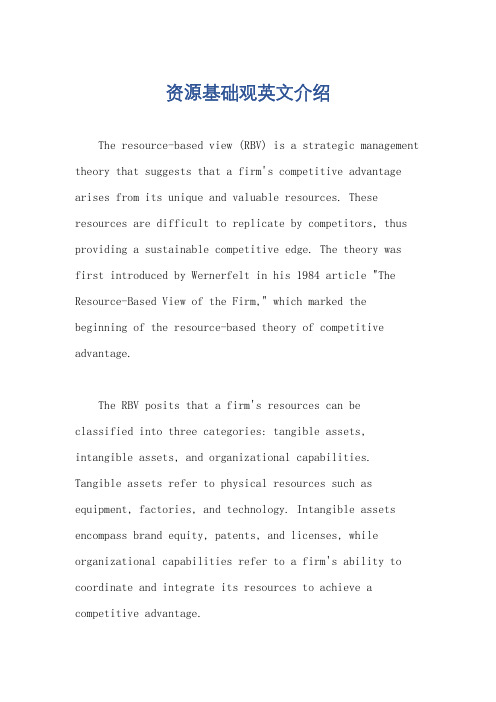
资源基础观英文介绍The resource-based view (RBV) is a strategic management theory that suggests that a firm's competitive advantage arises from its unique and valuable resources. These resources are difficult to replicate by competitors, thus providing a sustainable competitive edge. The theory was first introduced by Wernerfelt in his 1984 article "The Resource-Based View of the Firm," which marked the beginning of the resource-based theory of competitive advantage.The RBV posits that a firm's resources can beclassified into three categories: tangible assets, intangible assets, and organizational capabilities. Tangible assets refer to physical resources such as equipment, factories, and technology. Intangible assets encompass brand equity, patents, and licenses, while organizational capabilities refer to a firm's ability to coordinate and integrate its resources to achieve a competitive advantage.According to the RBV, the value of a firm's resources depends on their rarity, imitability, and substitutability. Resources that are rare and difficult to imitate are considered more valuable. Moreover, resources that are not easily substitutable by competitors also contribute to a firm's competitive advantage.The theory further suggests that a firm's competitive strategy should focus on leveraging its unique resources to create value for customers. By doing so, the firm can achieve above-average returns and maintain its competitive edge. To analyze a firm's resource position and develop strategic options, Wernerfelt proposed two economic tools: resource position barriers and the resource-product matrix.Resource position barriers refer to the obstacles that competitors face when trying to replicate a firm's unique resources. These barriers can arise from various factors such as legal protection, access to resources, and thefirm's ability to integrate its resources effectively. By identifying and strengthening these barriers, a firm canenhance its competitive advantage.The resource-product matrix is a tool that helps firms identify the products and services that can be developed using their unique resources. By mapping out the firm's resources and capabilities against potential products and services, managers can gain insights into which areas offer the greatest potential for competitive advantage.The RBV has since evolved and been applied in various contexts, including industry analysis, corporate strategy, and entrepreneurship. It has provided a valuable framework for understanding how firms can achieve and maintain competitive advantage through the effective management and development of their unique resources.In conclusion, the resource-based view offers a powerful theoretical framework for analyzing a firm's competitive advantage. By focusing on the unique resources and capabilities that are difficult to replicate by competitors, managers can develop strategies that leveragethese resources to create value for customers and maintain a sustainable competitive edge.。
人力资源管理专业术语中英文对照表

人力资源管理专业术语中英文对照表人力资源管理专业术语中英文对照表人力资源管理:Human Resource Management , HRM人力资源经理:Human resource manager高级管理人员:Executive职业:Profession道德标准:ethics操作工:operative employees专家:specialist人力资源认证协会:the human resource certification institute ,HRCI 外部环境:external environment内部环境:internal environment政策:policy企业文化:corporate culture目标:mission股东:shareholders非正式组织:informal organization跨国公司:multinational corporation ,MNC管理多样性:managing diversity工作:job职位:posting工作分析:job analysis工作说明:job description工作规范:job specification工作计划分析表:job analysis schedule ,JAS职位分析问卷调查法:Management position description questionnaire ,MPDQ 行政秘书:executive secretary地区服务经理助理:assistant disterict service manager人力资源计划:human resource planning HRP战略规划:strategic planning长期趋势:long term trend要求预测:requirement forecast供给预测:availability forecast管理人力储备:management inventory裁减:downsizing人力资源信息系统:human resource information system,HRIS招聘:recruitment员工申请表:employee requisition招聘方法:recruitment methods内部提升:promotion from within ,PFW工作公告:job posting广告:advertising职业介绍所:employment agency特殊事件:special events实习:internship选择:selection选择率:selection rate简历:resume标准化:standardization有效性:validity客观性:objectivity规范:norm录用分数线:cutoff score准确度:aiming业务知识测试:job knowledge tests求职面试:employment interview非结构化面试:unstructured interview 结构化面试:structured interview小组面试:group interview职业兴趣测试:vocational interest tests 会议型面试:board interview组织变化与人力资源开发人力资源开发:human resource development,HRD 培训:training开发:development定位:orientation训练:coaching辅导:mentoring经营管理策略:business games案例研究:case study会议方法:conference method角色扮演:role playing工作轮换:job rotating在职培训:on-the-job-training ,OJT媒介:media企业文化与组织发展:企业文化:corporation culture组织发展:organization development ,OD调查反馈:survey feedback质量圈:quality circles目标管理:management by objective ,MBO全面质量管理:T otal quality management ,TQM 团队建设:team building职业计划与发展职业:career职业计划:career planning职业道路:career path职业发展career development自我评价:self-assessment职业动机:career anchors绩效评价绩效评价:performance appraisal ,PA小组评价:group appraisal业绩评定表:rating scales method关键事件法:critical incident method排列法:ranking comparison平行比较法:paired comparison硬性分布法:forced distribution method晕圈错误:halo error宽松:leniency严格:strictness反馈:degree feedback叙述法:essay method集中趋势:central tendency报酬与福利报酬:compensation直接经济报酬:direct financial compensation 间接经济报酬:indirect financial compensation 非经济报酬:no financial compensation公平:equity外部公平:external equity内部公平:internal equity员工公平:employee equity小组公平:team equity工资水平领先者:pay leaders劳动力市场:labor market工作评价:job evaluation排列法:ranking method分类法:classification method因素比较法:factor comparison method评分法:point method海氏指示图标个人能力分析法:Hay Guide Chart –profile Method 工作定价:job pricing工资等级:pay grade工资曲线:wage curve工资幅度:pay range福利和其他报酬问题:福利(间接经济补偿)员工股权计划:employee stock ownership 破烂,ESOP值班津贴:shift differential奖金:incentive compensation分红制:profit sharing安全与健康的工作环境:安全:safety健康:health频率:frequency rate紧张:stress角色冲突:role conflict催眠法:hypnosis酗酒:alcoholism员工和劳动关系工会:union地方工会:local union行业工会:craft union全国工会:national union谈判组:bargaining union劳资谈判:collective bargaining仲裁:arbitration罢工:strike内部员工关系:internal employee relation 纪律:discipline纪律处分:disciplinary action申诉:grievance降职:demotion调动:transfer晋升:promotion部门名称人事部:personnel department人力资源部:human resource department营销部:salesman department产品开发部:product development department 公关部:public relationship department市场部:marketing department财会部:finance department采购部:purchasing (procurement)department 售后服务部:after-sale service department品管部:quality control department职位名称:董事长:chairman of the board总裁:president (Am E.)执行副总裁:executive vice – president行政董事:managing director总经理:executive manager ,general manager 副总经理:deputy general manager部门经理,科长:section manager销售部经理:sales manager助理经理(副经理):assistant manager主任:manager销售代表:sales representative主管:supervisor高中级管理人员:executive职员:clerkAccounting assistant 会计助理Accounting clerk 记账员Accounting manager 会计部助理Accounting stall 会计部职员Accounting supervisor 会计主管Administration manager 行政经理Administration staff 行政人员Administrative assistant 行政助理Administrative clerk 行政办事员Advertising staff 广告工作人员Airlines sales representative 航空公司订座员Airlines staff 航空公司职员Application engineer 应用工程师Assistant manager 副经理Bond analyst 证券分析员Bond trader 证券交易员Business controller 业务主任Business manager 业务经理Buyer 采购员Cashier 出纳员Chemical engineer 化学工程师Civil engineer 土木工程师Clerk / receptionist 职员/ 接待员Clerk typist & secretary 文书打字兼秘书Computer data input operator 计算机资料录入员Computer engineer 计算机工程师Computer processing operator 计算机处理操作员Computer system manager 计算机系统部经理Copywriter 广告文字撰稿人Deputy general manager 副总经理Economic research assistant 经济研究助理Electrical engineer 电气工程师English instructor / teacher 英语教师Export sales manager 外销部经理Export sales staff 外销部职员Financial controller 财务主任Financial reporter 财务报告人F.X. ( foreign exchange ) clerk 外汇部职员F.X. settlement clerk 外汇部核算员Fund manager 财务经理General auditor 审计长General manager / president 总经理General manager assistant 总经理助理General manager’s secretary 总经理秘书Hardware engineer (计算机)硬件工程师Import liaison staff 进口联络员Impor manager 进口部经理Insurance actuary 保险公司理赔员International sales staff 国际销售员Interpreter 口语翻译Legal adviser 法律顾问Line supervisor 生产线主管Maintenance engineer 维修工程师Management consultant 管理顾问Manager 经理Manager for public relations 公关部经理Manufacturing engineer 制造工程师Manufacturing engineer 制造工程师Manufacturing worker 生产员工Market analyst 市场分析员Market development manager 市场开发部经理Marketing manager 市场销售部经理Marketing staff 市场销售员Marketingassistant销售助理Marketing executive 销售主管Marketing representative 销售代表Marketing representative manager 市场调研部经理Mechanical engineer 机械工程师Mineing engineer 采矿工程师Music teacher 音乐教师Naval architect 造船工程师Office assistant 办公室助理Office clerk 职员Operational manager 业务经理Package designer 包装设计师Passenger reservation staff 乘客票位预订员Personnel clerk 人事部职员Personnel manager 人事部经理Plant / factory manager 厂长Postal clerk 邮政人员Private secretary 私人秘书Product manager 生产部经理Production engineer 产品工程师Professional staff 专业人员Programmer 电脑程序设计师Project staff (项目)策划人员Promotion manager 推销部经理Proof – reader 校对员Purchasing agent 采购(进货)员Quality control engineer 质量管理工程师Real estate staff 房地产职员Recruitment coordinator 招聘协调员Regional manager 地区经理Research & development engineer 研究开发工程师Restaurant manager 饭店经理Sales and planning staff 销售计划员Sales assistant 销售助理Sales clerk 店员、售货员Sales coordinator 销售协调员Sales engineer 销售工程师Sales executive 销售主管Sales manager 销售部经理Salesperson 销售员Seller representative 销售代表Sales supervisor 销售监管School registrar 学校注册主任Secretarial assistant 秘书助理Secretary 秘书Securities custody clerk 保安人员Security officer 安全人员Senior accountant 高级会计Senior consultant / adviser 高级顾问Senior employee 高级雇员Senior secretary 高级秘书Service manager 服务部经理Simultaneous interpreter 同声传译员Software engineer (计算机)软件工程师Supervisor 监管员Systems adviser 系统顾问Systems engineer 系统工程师Systems operator 系统操作员Technical editor 技术编辑Technical translator 技术翻译Technical worker 技术工人Telecommunication executive 电讯(电信)员T elephonist / operator 电话接线员、话务员Tourist guide 导游Trade finance executive 贸易财务主管Trainee manager 培训部经理Translation checker 翻译核对员Translator 翻译员Trust banking executive 银行高级职员Typist 打字员Word processing operator 文字处理操作员。
介绍人力资源的英语作文
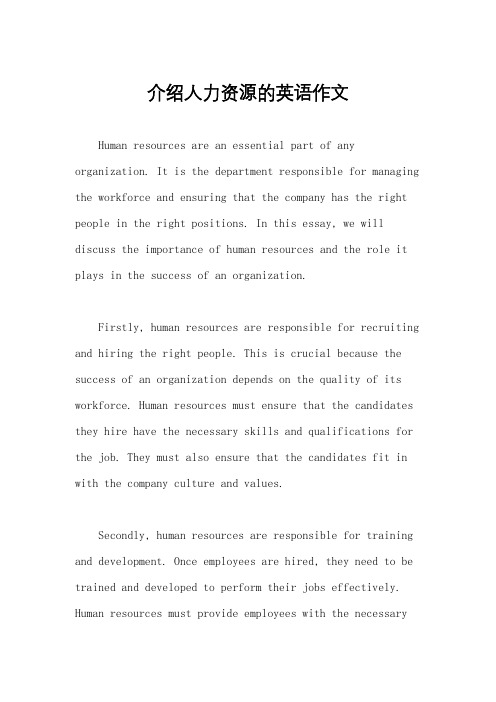
介绍人力资源的英语作文Human resources are an essential part of any organization. It is the department responsible for managing the workforce and ensuring that the company has the right people in the right positions. In this essay, we will discuss the importance of human resources and the role it plays in the success of an organization.Firstly, human resources are responsible for recruiting and hiring the right people. This is crucial because the success of an organization depends on the quality of its workforce. Human resources must ensure that the candidates they hire have the necessary skills and qualifications for the job. They must also ensure that the candidates fit in with the company culture and values.Secondly, human resources are responsible for training and development. Once employees are hired, they need to be trained and developed to perform their jobs effectively. Human resources must provide employees with the necessarytraining and development opportunities to help them grow and improve their skills. This will not only benefit the employees but also the organization as a whole.Thirdly, human resources are responsible for managing employee relations. This includes dealing with employee grievances, conflicts, and disciplinary actions. Human resources must ensure that employees are treated fairly and that their rights are protected. They must also ensure that the company’s policies and procedures are followed.Fourthly, human resources are responsible for compensation and benefits. This includes determining salaries, bonuses, and other benefits such as health insurance and retirement plans. Human resources must ensure that the compensation and benefits offered are competitive and fair.Finally, human resources are responsible for maintaining a safe and healthy work environment. This includes ensuring that the workplace is free from hazards and that employees are provided with the necessaryequipment and training to perform their jobs safely.In conclusion, human resources play a vital role in the success of an organization. They are responsible for recruiting and hiring the right people, training and developing employees, managing employee relations, determining compensation and benefits, and maintaining a safe and healthy work environment. Without human resources, organizations would struggle to attract and retain talented employees, which would ultimately impact their bottom line.。
- 1、下载文档前请自行甄别文档内容的完整性,平台不提供额外的编辑、内容补充、找答案等附加服务。
- 2、"仅部分预览"的文档,不可在线预览部分如存在完整性等问题,可反馈申请退款(可完整预览的文档不适用该条件!)。
- 3、如文档侵犯您的权益,请联系客服反馈,我们会尽快为您处理(人工客服工作时间:9:00-18:30)。
人力资源和企业资源基础观摘要企业的资源基础观(RBV)已经在多方面影响了战略人力资源管理(SHRM)领域。
本文探讨了RBV对SHRM的理论和实证发展的影响,探讨了战略和SHRM领域围绕一系列问题是如何趋于一致,并提出了这种一致性的一些含义。
1、绪论人力资源职能在为它在组织中的地位辩护方面一直存在争论(Drucker. 1954: Stewart. 1996)。
在富裕的时代,企业很容易为自己在培训、员工安置、奖金和员工参与系统的支出辩护,但是当面对财政困难时,这样的人力资源系统就会成为消减的牺牲品。
SHRM的次领域的到来,致力于探讨在支持企业发展战略方面的HR的作用,为证明它对企业的价值提供了一个途径。
Walker(1978)呼吁通过战略计划和人力资源计划的连接来显示SHRM领域的概念,但是在它出现的二十世纪八十年代,Devanna. Fombrum和Tichy(1984)的论文致力于广泛地探讨企业发展战略和HR的连接。
自那以后,SHRM的演变一直紧随(几年)战略管理领域的发展。
比如,Miles 和Snow(1978)的组织类型是扩展了包括相关HR系统(Miles & Snow. 1984),Porter (1980)的一般竞争战略模型后来被SHRM研究者用来描述超过任何人预测的特定的HR系统(Jackson & Schuler, 1987; Wright &Snell,1991)。
尽管SHRM领域不是直接产生于RBV,但是它明显是SHRM发展的工具。
这主要由于RBV重点转移到战略文献上,远离了外部方面(比如行业地位),转向诸如竞争优势源泉的企业内部资源(Hoskisson, Hitt, Wan &Yiu, 1999)。
诸如竞争优势源泉的内部资源越来越被认可合理地得出了HR的断言:人对企业成功具有战略重要性。
然而,考虑到HR价值的概念性辩护的需要和来自于广泛战略文献的概念和理论的SHRM领域的倾向性两方面,企业的RBV整合到SHRM文献中应该不令人意外。
尽管如此,这两方面的发展在过去十年前已经出现但不容易预测。
第一,在SHRM文献中,基于理论和实证检验,RBV的普及已经远远超过任何人的预测(McMahan, Virick & Wright, 1999)。
第二,在SHRM文献中,RBV的应用和含义已经导致了战略管理和SHRM领域逐渐趋向一致(Snell, Shadur & Wright, 2001)。
在SHRM文献中,RBV有助于将“人”(或者企业的人力资源)放在雷达网中。
类似于竞争优势源泉,诸如知识(Argote & Ingram, 2000; Grant, 1996, Leibeskind,1996)、动态能力(Eisenhardt & Martin, 2000; Teece, Pisano & Schuen, 1997)、学习型组织(Fiol & Lyles, 1985; Fisher & White, 2000)和领导力(Finkelstein& Hambrick, 1996; Norburn & Birley, 1988; Thomas, 1988)等概念转向战略和HR交叉的领域。
本文的目的是检验RBV如何运用于基于SHRM的理论和实证研究,以及探讨它是怎样为战略和SHRM领域提供一个易接近的桥梁。
为了实现这个目的,我们首先回顾一下将RBV运用到SHRM的理论发展的专门基准文献。
然后我们将讨论一些SHRM实证研究,它将在RBV的基础上探讨HR和企业绩效的关系。
最后,我们将区分一些主要前沿领域来分析战略和HR领域的一致,并对如此一致怎样能提供相互利益提出了一些未来导向。
2、运用RBV到SHRM基于Penrose (1959)和其他的工作,Wernerfelt' (1984)的企业RBV的清晰度确定地表明该理论的第一个一贯的描述。
该理论的最初描述作为基础被诸如Rumelt (1984), Barney (1996)和Dierickx 和 Cool (1989)其他人所扩展。
尽管如此,Barney(1991)关于可持续竞争优势的必要特点的详述是普及战略和其它领域理论的一篇种子文章。
在这篇文章中,他指出稀少、有价值、独特和不可替代的资源能产生可持续竞争优势的源泉。
尽管关于RBV的争论延续到工资(比如:RBV是否一个理论,它是否是同义反复等。
Priem & Butler. 2001a. b: Barney. 2001),即使是评论家已经承认在多个战略研究计划中“传播的幅度” (Priem& Butler. 2001a. p. 25-26)。
伴随诸如竞争优势源泉的内部资企业资源的强调,在SHRM文化中,RBV的普及已经没有什么意外。
自从Barnev ( 1991)的文章概括了可持续竞争优势源泉的基本理论模式和标准,RBV已不再遥远。
这个理论大部分运用到SHRM的理论发展和实证研究的基本原理两方面上(McMahan. Virick & Wright. 1999)。
3、RBV和SHRM理论作为Journal of Managemen管理年刊发行的一部分,Wright和McMahan (1992)综述了RBV已经运用于SHRM的理论观点。
他们指出RBV的一个观点,即RBV为企业人力资源如何提供可持续竞争优势的一个潜在源泉提供一个基本原理。
这主要是基于什么,当时是一份工作文件,后来成为McMahan和McWilliams (1994)随后描述的论文。
几乎同时, Cappelli和Singh (1992) 在劳资关系文献中提供RBV和SHRM的含义的一个检验。
确定地,他们指出了大多数SHRM模式建立在合适的假定上:(1)一个确定的企业发展战略要求来自员工的一套独特的行为和态度;(2)确定的人力资源政策产生出来自员工的一套独特的反应。
他们进一步指出,在战略方面大多含蓄地假定:基于战略选择的补充资产或资源重组比基于一套资产或资源的战略重组更容易,即使实证研究表明了相反的暗示。
然而,他们指出R BV可能为HR为什么拥有战略制定和实施的含义提供一个理论性的基本原理。
不久以后,两篇文章出现了讨论关于HR实践的几乎完全相反的的内在含义:HR实践是否构成了一个可持续竞争优势。
Wright et al. (1994)提到企业人力资源(比如人力资本池)和HR实践(这些HR工具用来管理人力资本池)的区分。
在运用有价值、稀少、独特和可替代概念基础上,他们指出HR实践不能形成可持续竞争优势的基础,因为任何单独的HR实践可能很容易被竞争对手复制。
相反,他们指出人力资本池(一个高技术和高驱动力的劳动力)有很大潜能构成一个可持续的竞争优势。
这些作者指出,为了构成可持续竞争优势源泉,人力资本池必须拥有高水平的技术和能展示生产行为的自发行为(比如动机)。
技术/行为的区分表现为这篇文献的相当一致的主题。
相比而言,Lado 和 Wilson (1994)指出企业的HR实践能提供可持续的竞争优势的一个源泉。
来自关于HR在影响企业能力方面的作用的观点,他们表明HR系统可能是独一无二的,在他们如何加强企业能力方面是临时不确定和协作的,然而它是独特的。
正如Wright et al.(1994)所讨论的个体实践的独特性那样,Lado和Wilson 指出,结合一系列实践的互补性和相关性,HR实践系统已经不可能被模仿。
这个观点看起来很好地被接受为现行SHRM范式(Snell, Youndt & Wright, 1996)。
Boxall (1996)进一步建立RBV/SHRM范式,该范式表明人力资源优势(比如一个企业人力资源管理超越其他企业的优越性)是由两部分构成的。
首先,人力资本优势意味着尽可能捕获一批具有“潜在生产能力”的特别人才(p. 67)。
人力资源程序优势被理解为一个“临时不确定性、社会复杂性、历史性进化过程的功能,比如学习、合作和创新”(p. 67)。
然后Boxall (1998)扩展了这个基本模式,它表现为SHRM的一个更加综合的模式。
他指出,组织的一个主要任务是相互管理(比如利益联盟),它的目的是培养一个天才的和忠诚的劳动力。
正是这个任务的成就产生了人力资本优势。
第二个任务是为了员工和团队发展,这样可以在工业周期内培养组织的学习能力。
这项任务的成功成就产生了组织流程优势。
更近的是,Lepak 和 Snell (1999)提出了一个至少部分基于RBV的SHRM的结构模式。
他指出,在组织里,相当差别存在于技能的唯一性和价值两方面。
把这两个方面并列,他们建立了一个2 x 2矩阵来描述他们相一致的员工关系和HR系统的不同组合。
这个模式的主要含义是一些员工群体比其他的更有利于竞争优势。
因此,他们可能是不同地被管理。
当一个结构观点的提出是根源于关于HR(cf., Baron et al., 1986; Osterman,1987; Tsui, Pearce, Porter & Tripoli, 1997)和战略(cf., Matusik & Hill, 1998)的现行研究时,Lepak 和Snell (1999)帮助SHRM研究者确认了真实有效的差别存在于组织的HR实践中,以及寻找一个HR战略可能掩盖了适用于企业的不同类型人力资本的重要区别 (cf. Truss & Gratton, 1994)。
本质上讲, SHRM领域下的概念发展已经推动RBV来实现人力资源结构某些方面的一致, 这个结构可能实现可持续竞争优势。
图1描述了这些部分。
首先,人力资本池涉及到员工技能储备,它在任何时候都存在于企业中。
理论家侧重发展一批人力资本的需要,所谓人力资本是高水平的技术(一般和/或确定的细节),或者是在企业代表技术和其战略意图所要求的技术二者之间达到很好的结合。
人力资本的现存储备能够和随着时间推移改变,并且它必须时常被监控以确保与企业战略需要相匹配。
其次,许多研究者逐步达成一致:员工行为是SHRM的一个重要的独立部分。
在区分人力资本池的技术下,员工行为识别拥有自由愿望的个体认知和情感存在。
这个自由愿望确保他们根据他们将要实施的行为做出决定。
这是很重要,即使是微小的,可区分的。
人力资本理论的一个基本前提是企业不能拥有它而个人可以拥有它。
企业可能使用有价值的人力资本,但是工作的低水平设计和人员的管理不善不可能适当地调配它实现战略影响。
MacDuffie (1995)主要集中在自由行为方面。
自由行为识别描述性组织角色和员工表现自由,对企业来说员工表现自由可能有正面或负面的结果。
